Why does it seem like every night is the same for me lately...
-get home from work
-eat food (or dinner, depending on what time)
-listen to Sheer Terror
-have a beer and read
-finish reading and beer
-end up listening to the Exploding Hearts
School could start again tomorrow, for all I care.
Saturday, August 21, 2010
Wednesday, July 21, 2010
Once again, it seems that I've bitten off more than I can chew, 16 books...coming up.
Also, I'm going to try and break this down a little bit this time, from now on I'm going to try and figure out ways to organize the books categorically so it seems less intimidating than the former wall of text.
Penguin Great Ideas

Kicking this off with volume 13 of Penguin's Great Ideas series, and it just so happens to be The Communist Manifesto by Karl Marx and Friedrich Engels. For only the second time so far in the series has there been a work that has made such a clear drastic impact on the world (the first being Machiavelli's The Prince, number 5 of the series). And as such, reading through this I felt like I had already read it before due to the number of times I've seen it referenced in other works, or talked about. That being said, the one section that was entirely new and really stood out to me was the discussion on what was called "Conservative or Bourgeois Socialism" in which members of ruling classes themselves support socialist causes as a way to stem the tide and maintain the current social order. I feel like this where the ideas of academic Marxism come into play, and the idea promoted in a post-secondary environment that everyone should praise socialism as an ideal society, yet at the same time fails to promote (and sometimes discourages) even the slightest efforts to enact a meaningful societal change. The fact that socialism has been relegated to the sidelines of society like this makes it seem like the conservative socialists came out on top, unfortunately.
That aside, I'm not entirely sure what gets included with other editions of The Communist Manifesto, but the Great Ideas edition includes a variety of early introductions as they were revised over time by Marx and Engels (and just Engels, after Marx's death) in accordance to the political climates at the time. Also included is the essay The Eighteenth Brumaire of Louis Napoleon, in which Marx recounts the events leading up to and following shortly after Louis-Napoleon Bonaparte declared himself the dictator of France shortly after the French Revolution of 1851. It was an interesting read, but I feel like I didn't know enough of the history behind the coup to fully grasp what Marx was saying, this is something I'll have to come back to. Excellent read, and something that I feel everyone should pick up and read once in their life, instead of just talking about it like they have (an offence I've been guilty of a few times).
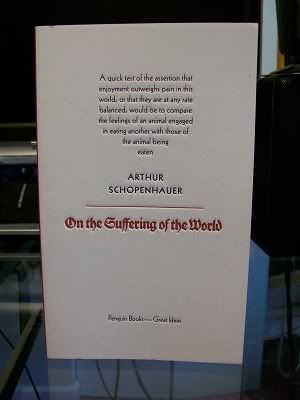
Shifting from Marx and Engels's ultimately positive work to what has thus far been the most depressing and inflammatory read of the Great Idea series. Arthur Schopenhauer's On The Suffering Of The World is a collection of the German philosopher's essays on varying topics, but one concept that runs central in all of the works is a statement he makes in the first essay, Schopenhauer states that all pain and suffering in the world is positive, due to the fact that they occur far more naturally and routinely than feelings of happiness and gratification, which he deems as negative due to the fact that they are simply the "mere abolition of desire and extinction of a pain". Through this lens he tackles everything from vanity, death, suicide and thinking to the subject of women.
His essay simply titled On Women is widely known as Schopenhauer's heavy handed attack on the fledgling feminism movement, along with a society that allows women that sort of power. In this work Schopenhauer exhibits what is perhaps one of the most ignorant things I have ever read, calling women everything from "the weaker sex" to his statement that "Neither for music, nor poetry, nor the plastic arts do they possess any real feeling or receptivity: if they affect to do so it is merely mimicry in service of their effort to please". You might be reading this and thinking "well it was the times, man", but if you read the entire essay you would realize that it's even a little extreme for the mid 19th century. However, this work has a train-wreck quality to it and in that sense that I'm glad it's still being published, it is still an incredibly interesting read, even if what he was saying did warrant a punch in the head. All in all, probably one of my favourite books of all time simply due to the variety (and intensity) of emotional responses it drew.
Magazines
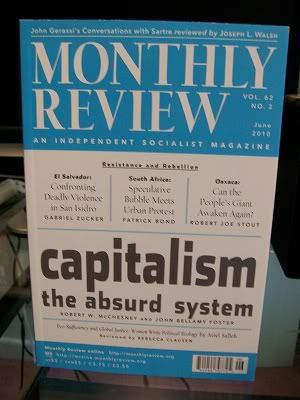
Jumping into magazines now, and keeping with the theme of the first book in this post, I was glad to pick up the next issue of Monthly Review, which happens to be Volume 62 Number 02. I enjoyed the last issue I read quite a bit but I still felt that this one was leaps and bounds better. This is probably due to the fact that the primary cover story, Capitalism, The Absurd System by Robert W. McChesney and John Bellamy Foster makes a statement that I (along with many others, I'm sure) can greatly appreciate and agree with, that being that there is no legitimate leftist option in the political arena. They applied it to the American political parties, but it applies even more so in Canada. They mention that the democratic party (and by default the NDP and Liberals, in Canada) are far too afraid of polarizing public opinion to drift even further left, along with the fact that drifting left eventually abandons Capitalism, which is apparently bad news for a political party. I agree whole heartedly, and this story plus all three other stories in this issue (regarding activist murders in El Savador, Urban protest to neoliberal policies in South Africa, and the sadly temporary revolutionary action in Oaxaca, Mexico) are just as great. Finally, this issue concludes with a book review titled Sartre: Conversations with a "Bourgeois Revolutionary", for John Gerassi's Talking with Sartre: Conversations and Debates, slightly hypocritical after my rant on conservative socialism, but c'est la vie. I'm not missing out on a chance to read Sartre himself discussing his political views, among other things.

Shifting a little in content with this one, McSweeney's Publishing does it again with the 72nd issue of their monthly magazine The Believer. Featuring an always eclectic assortment of articles ranging from the slow ongoing downfall of Freetown Christiana, an autonomous community in Denmark to an article by Michael G. Powell on the history of Sharpie permanent markers. The highlight for me, however was a great interview with KCW's Bookworm host Michael Silverblatt in which he explained how he got to the position he is in, what makes an interview great, and most amazing reveals that before he interviews an author he makes his absolute best attempt to read that author's entire body of work. A daunting task for sure, that is serious dedication on his part.
Also included is another great comics section edited by Alvin Buenaventura who sadly had to recently shut down his printing company, Buenaventura Press. I'm glad that he's still in charge of this though because they are great. And as usual, Nick Hornby amazes me with Stuff I've Been Reading, in which he amusingly rambles on about his life and things he's read. He's been raving about David Kynaston's Austerity Britain for two issues now, and it's really tempting me to go pick it up, despite the fact that it's apparently a massive book and the fact that I've never set foot in Britain. He talks it up real well, I gotta say. Oh, and Hornby went to the Oscars, which leads to an amusing tangent. Pick up this issue if you like to read....well anything really. If you like comics, poetry, interviews, books, history, useless facts, anything.
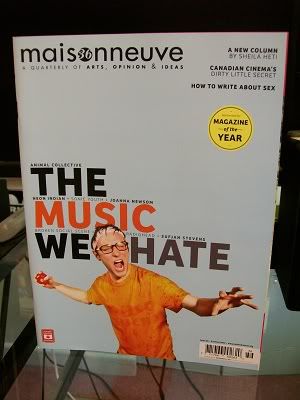
Finally in the trio of magazines from this batch of books is issue 36 of the great Canadian magazine Maisonneuve, a "quarterly of arts, opinion & ideas". Or as I like to call it, "the magazine that's good enough that I probably would have checked it out anyway but I think I just bought it for the Chris Ware comic". Seriously, I read a friend's copy of their last issue on a long bus ride a couple months back, and it was then that I realized that this is where Chris Ware has been hiding his comics lately, along with the fact that this magazine was from that point on on my "to buy" list.
But as I mentioned, this isn't a one trick pony either. This issue had two articles that were so full of Canadiana I could smell the maple syrup and back bacon a mile away. The first was a photo essay titled From Holyrood to Brigus by photographer Scott Walden, using photos from his series All the Clubs from Holyrood to Brigus, a series of club and legion hall photos from rural Newfoundland, and Newfoundlander poet Mary Dalton accompanies those photos with prose poems. Things like this make me almost feel depraved of growing up in southern Ontario. I feel like I'm missing out on the few things that give Canada it's unique cultural heritage (I know, it's more than Legion halls and dive bars, but there is no denying that they play a part). And on a more light hearted note, is The Eh-List, as writer John Semley sheds some light on the forgotten (or conveniently ignored) world of Canadian b-film, or as it is lovingly termed, Canuxploitation. All that I know is that just reading this article alone added a good dozen movies to my list of things I wanted to see, and then I did some digging and found this site. Thank you, John Semley, for devouring yet another chunk of my free time. These articles (and Chris Ware's EXCELLENT comic) are just the tip of the iceberg for this great (and inexpensive, sitting at $6.95 CDN) quarterly, if you never listen to anything else I say on here, do yourself a favour and read this.
Comics
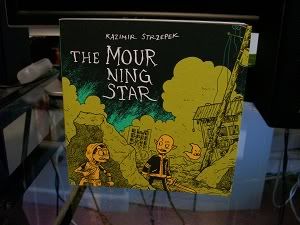
First of the comics is Kazimir Strzepek's The Mourning Star Vol.1, telling the story of a a trio trying to survive in a post-apocalyptic fantasy world. At first, I was a little apprehensive because I didn't know how I felt about the art style. I thought it was a little too Asian influenced for me, but as I read I think I came to terms with the fact that Manga, much like western cartooning can be awful or not awful, this falls into the latter. In addition to this, it has a great central cast of likable (for the most part) characters, and enough action and gore to keep someone like me entertained. Also, Strzepek created an entire alphabet for one of the tribes in this book to use, and included a tool to decipher it at the end of the book, which I thought fucking ruled and to be honest I think that's what really sold me on this book. This would be good if you like fantasy settings and adventure plots, and it was a nice break from the sort of comic I usually read.
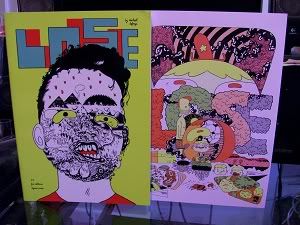
Speaking of "the sort of comic I usually read", I was really impressed with Toronto's Michael Deforge (who I know I've raved about before, so I'll save it this time) and the first two issues of his comic, titled Lose. Both of these are great, with a couple shorter strips included in each. The personal highlights for me were Dogs in College in the first issue, along with Cave Adventure from issue two, both being excellently drawn and hilarious. Really though, DeForge's drawing style alone was enough for me to pick these up, the fact that he just so happens to be great at writing funny strips is just an added bonus. Like comics? get this. Live in Toronto? get this. Hate everything? still get this.
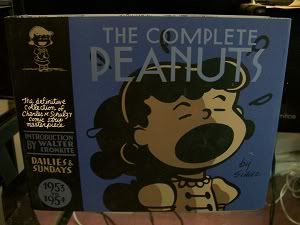
Next up is the second edition of Fantagraphics Books' The Complete Peanuts Collection, collecting every daily and Sunday strip from 1953-1954, plus a couple neat extras. Much like the first edition, this is laid out wonderfully, with an introduction by American journalist and anchorman Walter Cronkite that can only be described as "really cool". This volume also features the introduction of Pigpen, the Peanuts resident crust punk and one of my favourite characters. Also introduced Charlotte Braun, the short lived female counterpart to Charlie Brown, who's running joke was that she TALKED REALLY LOUD. I thought it was hilarious, but I guess Schulz didn't, considering he cut her from the strip so quickly.
This issue shows that Schulz was in full swing with the characters as opposed to the first couple of years where it was clear that he was getting his footing when it came to writing Charlie and the gang. If you can, pick up the box set of these two first volumes, it's something you don't want to miss.
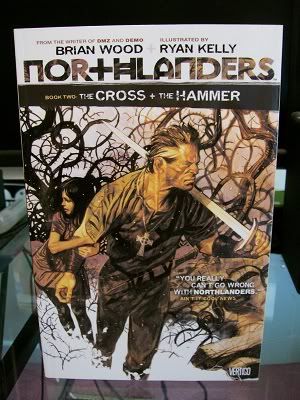
From some kids playing in their neighbourhood to pissed off Irishmen trying to keep invading Vikings off their land, this is the second collection of Brian Wood's Northlanders. I was a little surprised by the fact that this has an entirely different setting and cast of characters than the first book, but once I thought about it, considering this is a series about the impact of viking settlements in Europe as a whole. And besides, I like these characters even more.
Featuring an Irishman and his daughter Brigid, this comic has the most (and best) gore I've seen in a long time. The Irishman kills like the Punisher on speed, murdering anyone he stumbles across who he thinks invaded his country. I should have kept a tally of all the deaths as I read this, I imagine it's 50+, and they're all illustrated in wonderfully graphic detail. If you're into comics with a real loose historical background, superb art and tons of violence I don't know why you wouldn't get into this series.
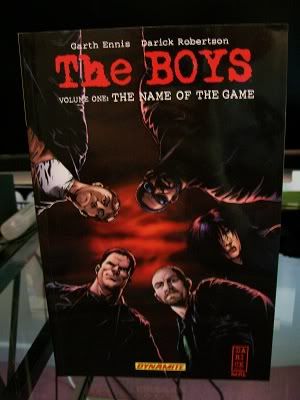
Speaking of comics with "mature themes", I picked up the first volume of Garth Ennis' The Boys, a story of a team of five humans who decide that they need to rid the world of superheros before they wise up and take over the world. Oh, and one of the characters is illustrated as British actor/writer Simon Pegg, just to up the stakes of weirdness a little.
I'm used to picking up comics with warnings about mature content and not really finding anything objectionable in them, but I was glad that I got the bang for my buck on this one. From the back cover illustration of a superhero getting his head stomped on pavement to the numerous sex scenes throughout the book it really did feel as gritty as it should have, and even to the point that I think Ennis would have been hard pressed to publish this material through Marvel (even the MAX imprint) just because of content. My only gripe is the art and colouring in specific, it's real clear that it a largely digital process, with the pictures looking airbrushed and cheesy. I'll give this another volume or two to see if it shapes up, but other than that I can't really see myself continuing on with this series, bummer too because I really enjoy the content.
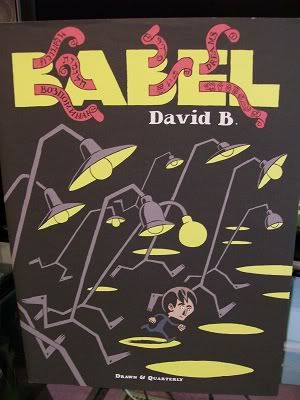
Next up are a group of comics from Fantagraphics Books' Ignatz Series, a series of comics collected and edited by Italian artist Igort, all of them are a uniform size with really nice slipcovers and great stories. This is Ignatz #0, French artist David B.'s Babel issue 1. easily my favourite of the first four books of the series, Babel is a semi-autobiographical story of the artist mixed in with amazing dream sequences and other side stories. David B.'s art takes on a great almost primal feel because of the great use of simple movement and shapes paired with the fact that he was limited (as all Ignatz series artists are) to only three colours per book. I love the surreal feeling of this book, adn I'm looking forward to picking up number two as soon as I can.
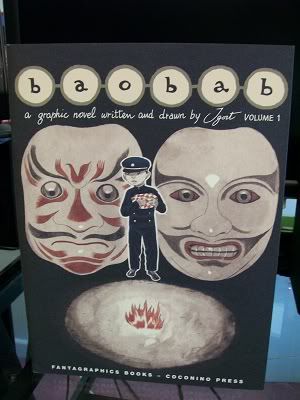
The official beginning to the Ignatz series is Igort's own contribution, Baobab issue 1. Much like Babel, this is a story focusing on a Japanese child Hirohsi learning about his family and imagining his own version of those stories. Meanwhile, in South America an older man, Celestino decides that he is gong to be a story teller and takes to drawing comics for a local newspaper. I feel like in future issues these two plots will converge and it will be really good. The art in this book is much more reserved than that of Babel, choosing to work only in pale blue watercolour and black Igort creates a style of art that looks both very conservative and regal when drawing the Japan scenes, but also has a great dreamlike quality when it comes to both Hiroshi's imagination and Celestino's comics. Excellent book, I'm also looking forward to getting the next issue of this.
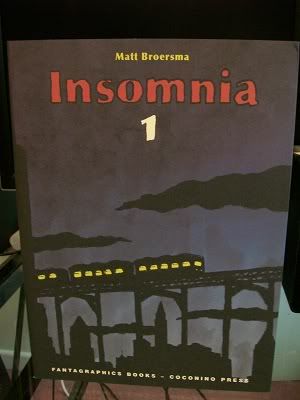
Next is Ignatz #2 with Matt Broersma's Insomnia issue one. A much more complicated narrative than either of the other two Ignatz titles so far, this opens up with a room full of slightly inebriated story-telling skeletons before it switches into the store which comprises the real meat of this issue, Eldorado. Telling the story of a fugitive making a mad dash to Mexico, Eldorado shows Dr. John Bentley getting into situations that may or may not include a drug dealer and a scene with a underwater macabre mariachi band, good stuff. Using a colour choice similar to that of Igort, Broersma's drawing is much sketchier than that of the Italian artist, leading to an art style that fits the mood of both stories contained here. Dark blues and black dominate every frame and it looks really full and dark, the intention, I'm sure. This is good, but compared to the other three of this batch I'm going to have to say that it's the weakest of the round.
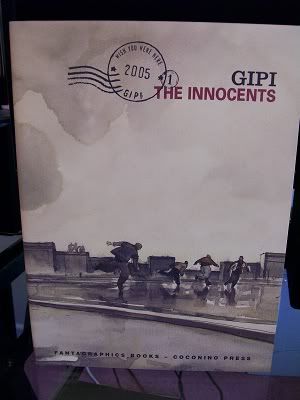
Closing out the last of these four Ignatz Series components is another Italian cartoonist, Gipi with the first issue of his series Wish You Were Here: The Innocents, telling the story of an uncle on an outing with his nephew as they decide to skip out on the original plan of going to an amusement park and opt to hangout with one of the Uncle's former gang buddies. I think this was my favourite of the four books in terms of story, it's great to see the uncle learning about ow to behave around his nephew, along with nephew's maturity towards the situations that unfold, great characters. Also, the art changes completely from the normal art to a real basic line drawing format for flashback scenes, a technique that seems to be running rampant throughout this series but one that continues to impress me, either way. I'm eager to read the next segment Gipi writes of this series.

From the highbrow to the lowbrow, here's issue two of Wowee Zonk published by the Toronto collective conveniently named Wowee Zonk. Feature work by great artists like Chris Kuzma, Michael Deforge (again), Patrick Kyle and more, this hodgepodge of different short strips is amazing, both in content and art style. From underwater sex to a repeating strip called Scrote which is just a floating head berating his life, this is sure to have something for everyone. And so it should. I'm not sure what else to say about this other than it fucking rules and if you don't believe me I think you should buy so I can prove you very wrong.
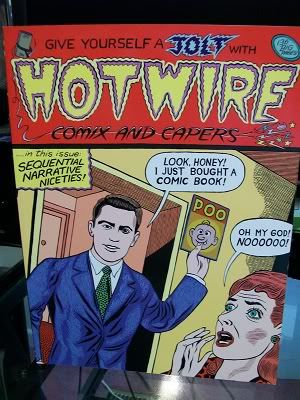
The final book in this ridiculous marathon of reviews is the first volume of Hotwire Comix and Capers, a collection of various artists put together and edited by Glenn Head. Along with a great cover by the hilarious Michael Kupperman. With a collection as large as this (39 works in total) there are bound to be ups and downs but I think this one has a greater quantity of the former. Great quality throughout, and I'm looking forward to picking up the other two volumes that have already been released. I can't think of anything else to say, my brain hurts.
Fin.
Also, I'm going to try and break this down a little bit this time, from now on I'm going to try and figure out ways to organize the books categorically so it seems less intimidating than the former wall of text.
Penguin Great Ideas

Kicking this off with volume 13 of Penguin's Great Ideas series, and it just so happens to be The Communist Manifesto by Karl Marx and Friedrich Engels. For only the second time so far in the series has there been a work that has made such a clear drastic impact on the world (the first being Machiavelli's The Prince, number 5 of the series). And as such, reading through this I felt like I had already read it before due to the number of times I've seen it referenced in other works, or talked about. That being said, the one section that was entirely new and really stood out to me was the discussion on what was called "Conservative or Bourgeois Socialism" in which members of ruling classes themselves support socialist causes as a way to stem the tide and maintain the current social order. I feel like this where the ideas of academic Marxism come into play, and the idea promoted in a post-secondary environment that everyone should praise socialism as an ideal society, yet at the same time fails to promote (and sometimes discourages) even the slightest efforts to enact a meaningful societal change. The fact that socialism has been relegated to the sidelines of society like this makes it seem like the conservative socialists came out on top, unfortunately.
That aside, I'm not entirely sure what gets included with other editions of The Communist Manifesto, but the Great Ideas edition includes a variety of early introductions as they were revised over time by Marx and Engels (and just Engels, after Marx's death) in accordance to the political climates at the time. Also included is the essay The Eighteenth Brumaire of Louis Napoleon, in which Marx recounts the events leading up to and following shortly after Louis-Napoleon Bonaparte declared himself the dictator of France shortly after the French Revolution of 1851. It was an interesting read, but I feel like I didn't know enough of the history behind the coup to fully grasp what Marx was saying, this is something I'll have to come back to. Excellent read, and something that I feel everyone should pick up and read once in their life, instead of just talking about it like they have (an offence I've been guilty of a few times).

Shifting from Marx and Engels's ultimately positive work to what has thus far been the most depressing and inflammatory read of the Great Idea series. Arthur Schopenhauer's On The Suffering Of The World is a collection of the German philosopher's essays on varying topics, but one concept that runs central in all of the works is a statement he makes in the first essay, Schopenhauer states that all pain and suffering in the world is positive, due to the fact that they occur far more naturally and routinely than feelings of happiness and gratification, which he deems as negative due to the fact that they are simply the "mere abolition of desire and extinction of a pain". Through this lens he tackles everything from vanity, death, suicide and thinking to the subject of women.
His essay simply titled On Women is widely known as Schopenhauer's heavy handed attack on the fledgling feminism movement, along with a society that allows women that sort of power. In this work Schopenhauer exhibits what is perhaps one of the most ignorant things I have ever read, calling women everything from "the weaker sex" to his statement that "Neither for music, nor poetry, nor the plastic arts do they possess any real feeling or receptivity: if they affect to do so it is merely mimicry in service of their effort to please". You might be reading this and thinking "well it was the times, man", but if you read the entire essay you would realize that it's even a little extreme for the mid 19th century. However, this work has a train-wreck quality to it and in that sense that I'm glad it's still being published, it is still an incredibly interesting read, even if what he was saying did warrant a punch in the head. All in all, probably one of my favourite books of all time simply due to the variety (and intensity) of emotional responses it drew.
Magazines

Jumping into magazines now, and keeping with the theme of the first book in this post, I was glad to pick up the next issue of Monthly Review, which happens to be Volume 62 Number 02. I enjoyed the last issue I read quite a bit but I still felt that this one was leaps and bounds better. This is probably due to the fact that the primary cover story, Capitalism, The Absurd System by Robert W. McChesney and John Bellamy Foster makes a statement that I (along with many others, I'm sure) can greatly appreciate and agree with, that being that there is no legitimate leftist option in the political arena. They applied it to the American political parties, but it applies even more so in Canada. They mention that the democratic party (and by default the NDP and Liberals, in Canada) are far too afraid of polarizing public opinion to drift even further left, along with the fact that drifting left eventually abandons Capitalism, which is apparently bad news for a political party. I agree whole heartedly, and this story plus all three other stories in this issue (regarding activist murders in El Savador, Urban protest to neoliberal policies in South Africa, and the sadly temporary revolutionary action in Oaxaca, Mexico) are just as great. Finally, this issue concludes with a book review titled Sartre: Conversations with a "Bourgeois Revolutionary", for John Gerassi's Talking with Sartre: Conversations and Debates, slightly hypocritical after my rant on conservative socialism, but c'est la vie. I'm not missing out on a chance to read Sartre himself discussing his political views, among other things.

Shifting a little in content with this one, McSweeney's Publishing does it again with the 72nd issue of their monthly magazine The Believer. Featuring an always eclectic assortment of articles ranging from the slow ongoing downfall of Freetown Christiana, an autonomous community in Denmark to an article by Michael G. Powell on the history of Sharpie permanent markers. The highlight for me, however was a great interview with KCW's Bookworm host Michael Silverblatt in which he explained how he got to the position he is in, what makes an interview great, and most amazing reveals that before he interviews an author he makes his absolute best attempt to read that author's entire body of work. A daunting task for sure, that is serious dedication on his part.
Also included is another great comics section edited by Alvin Buenaventura who sadly had to recently shut down his printing company, Buenaventura Press. I'm glad that he's still in charge of this though because they are great. And as usual, Nick Hornby amazes me with Stuff I've Been Reading, in which he amusingly rambles on about his life and things he's read. He's been raving about David Kynaston's Austerity Britain for two issues now, and it's really tempting me to go pick it up, despite the fact that it's apparently a massive book and the fact that I've never set foot in Britain. He talks it up real well, I gotta say. Oh, and Hornby went to the Oscars, which leads to an amusing tangent. Pick up this issue if you like to read....well anything really. If you like comics, poetry, interviews, books, history, useless facts, anything.

Finally in the trio of magazines from this batch of books is issue 36 of the great Canadian magazine Maisonneuve, a "quarterly of arts, opinion & ideas". Or as I like to call it, "the magazine that's good enough that I probably would have checked it out anyway but I think I just bought it for the Chris Ware comic". Seriously, I read a friend's copy of their last issue on a long bus ride a couple months back, and it was then that I realized that this is where Chris Ware has been hiding his comics lately, along with the fact that this magazine was from that point on on my "to buy" list.
But as I mentioned, this isn't a one trick pony either. This issue had two articles that were so full of Canadiana I could smell the maple syrup and back bacon a mile away. The first was a photo essay titled From Holyrood to Brigus by photographer Scott Walden, using photos from his series All the Clubs from Holyrood to Brigus, a series of club and legion hall photos from rural Newfoundland, and Newfoundlander poet Mary Dalton accompanies those photos with prose poems. Things like this make me almost feel depraved of growing up in southern Ontario. I feel like I'm missing out on the few things that give Canada it's unique cultural heritage (I know, it's more than Legion halls and dive bars, but there is no denying that they play a part). And on a more light hearted note, is The Eh-List, as writer John Semley sheds some light on the forgotten (or conveniently ignored) world of Canadian b-film, or as it is lovingly termed, Canuxploitation. All that I know is that just reading this article alone added a good dozen movies to my list of things I wanted to see, and then I did some digging and found this site. Thank you, John Semley, for devouring yet another chunk of my free time. These articles (and Chris Ware's EXCELLENT comic) are just the tip of the iceberg for this great (and inexpensive, sitting at $6.95 CDN) quarterly, if you never listen to anything else I say on here, do yourself a favour and read this.
Comics

First of the comics is Kazimir Strzepek's The Mourning Star Vol.1, telling the story of a a trio trying to survive in a post-apocalyptic fantasy world. At first, I was a little apprehensive because I didn't know how I felt about the art style. I thought it was a little too Asian influenced for me, but as I read I think I came to terms with the fact that Manga, much like western cartooning can be awful or not awful, this falls into the latter. In addition to this, it has a great central cast of likable (for the most part) characters, and enough action and gore to keep someone like me entertained. Also, Strzepek created an entire alphabet for one of the tribes in this book to use, and included a tool to decipher it at the end of the book, which I thought fucking ruled and to be honest I think that's what really sold me on this book. This would be good if you like fantasy settings and adventure plots, and it was a nice break from the sort of comic I usually read.

Speaking of "the sort of comic I usually read", I was really impressed with Toronto's Michael Deforge (who I know I've raved about before, so I'll save it this time) and the first two issues of his comic, titled Lose. Both of these are great, with a couple shorter strips included in each. The personal highlights for me were Dogs in College in the first issue, along with Cave Adventure from issue two, both being excellently drawn and hilarious. Really though, DeForge's drawing style alone was enough for me to pick these up, the fact that he just so happens to be great at writing funny strips is just an added bonus. Like comics? get this. Live in Toronto? get this. Hate everything? still get this.

Next up is the second edition of Fantagraphics Books' The Complete Peanuts Collection, collecting every daily and Sunday strip from 1953-1954, plus a couple neat extras. Much like the first edition, this is laid out wonderfully, with an introduction by American journalist and anchorman Walter Cronkite that can only be described as "really cool". This volume also features the introduction of Pigpen, the Peanuts resident crust punk and one of my favourite characters. Also introduced Charlotte Braun, the short lived female counterpart to Charlie Brown, who's running joke was that she TALKED REALLY LOUD. I thought it was hilarious, but I guess Schulz didn't, considering he cut her from the strip so quickly.
This issue shows that Schulz was in full swing with the characters as opposed to the first couple of years where it was clear that he was getting his footing when it came to writing Charlie and the gang. If you can, pick up the box set of these two first volumes, it's something you don't want to miss.

From some kids playing in their neighbourhood to pissed off Irishmen trying to keep invading Vikings off their land, this is the second collection of Brian Wood's Northlanders. I was a little surprised by the fact that this has an entirely different setting and cast of characters than the first book, but once I thought about it, considering this is a series about the impact of viking settlements in Europe as a whole. And besides, I like these characters even more.
Featuring an Irishman and his daughter Brigid, this comic has the most (and best) gore I've seen in a long time. The Irishman kills like the Punisher on speed, murdering anyone he stumbles across who he thinks invaded his country. I should have kept a tally of all the deaths as I read this, I imagine it's 50+, and they're all illustrated in wonderfully graphic detail. If you're into comics with a real loose historical background, superb art and tons of violence I don't know why you wouldn't get into this series.

Speaking of comics with "mature themes", I picked up the first volume of Garth Ennis' The Boys, a story of a team of five humans who decide that they need to rid the world of superheros before they wise up and take over the world. Oh, and one of the characters is illustrated as British actor/writer Simon Pegg, just to up the stakes of weirdness a little.
I'm used to picking up comics with warnings about mature content and not really finding anything objectionable in them, but I was glad that I got the bang for my buck on this one. From the back cover illustration of a superhero getting his head stomped on pavement to the numerous sex scenes throughout the book it really did feel as gritty as it should have, and even to the point that I think Ennis would have been hard pressed to publish this material through Marvel (even the MAX imprint) just because of content. My only gripe is the art and colouring in specific, it's real clear that it a largely digital process, with the pictures looking airbrushed and cheesy. I'll give this another volume or two to see if it shapes up, but other than that I can't really see myself continuing on with this series, bummer too because I really enjoy the content.

Next up are a group of comics from Fantagraphics Books' Ignatz Series, a series of comics collected and edited by Italian artist Igort, all of them are a uniform size with really nice slipcovers and great stories. This is Ignatz #0, French artist David B.'s Babel issue 1. easily my favourite of the first four books of the series, Babel is a semi-autobiographical story of the artist mixed in with amazing dream sequences and other side stories. David B.'s art takes on a great almost primal feel because of the great use of simple movement and shapes paired with the fact that he was limited (as all Ignatz series artists are) to only three colours per book. I love the surreal feeling of this book, adn I'm looking forward to picking up number two as soon as I can.

The official beginning to the Ignatz series is Igort's own contribution, Baobab issue 1. Much like Babel, this is a story focusing on a Japanese child Hirohsi learning about his family and imagining his own version of those stories. Meanwhile, in South America an older man, Celestino decides that he is gong to be a story teller and takes to drawing comics for a local newspaper. I feel like in future issues these two plots will converge and it will be really good. The art in this book is much more reserved than that of Babel, choosing to work only in pale blue watercolour and black Igort creates a style of art that looks both very conservative and regal when drawing the Japan scenes, but also has a great dreamlike quality when it comes to both Hiroshi's imagination and Celestino's comics. Excellent book, I'm also looking forward to getting the next issue of this.

Next is Ignatz #2 with Matt Broersma's Insomnia issue one. A much more complicated narrative than either of the other two Ignatz titles so far, this opens up with a room full of slightly inebriated story-telling skeletons before it switches into the store which comprises the real meat of this issue, Eldorado. Telling the story of a fugitive making a mad dash to Mexico, Eldorado shows Dr. John Bentley getting into situations that may or may not include a drug dealer and a scene with a underwater macabre mariachi band, good stuff. Using a colour choice similar to that of Igort, Broersma's drawing is much sketchier than that of the Italian artist, leading to an art style that fits the mood of both stories contained here. Dark blues and black dominate every frame and it looks really full and dark, the intention, I'm sure. This is good, but compared to the other three of this batch I'm going to have to say that it's the weakest of the round.

Closing out the last of these four Ignatz Series components is another Italian cartoonist, Gipi with the first issue of his series Wish You Were Here: The Innocents, telling the story of an uncle on an outing with his nephew as they decide to skip out on the original plan of going to an amusement park and opt to hangout with one of the Uncle's former gang buddies. I think this was my favourite of the four books in terms of story, it's great to see the uncle learning about ow to behave around his nephew, along with nephew's maturity towards the situations that unfold, great characters. Also, the art changes completely from the normal art to a real basic line drawing format for flashback scenes, a technique that seems to be running rampant throughout this series but one that continues to impress me, either way. I'm eager to read the next segment Gipi writes of this series.

From the highbrow to the lowbrow, here's issue two of Wowee Zonk published by the Toronto collective conveniently named Wowee Zonk. Feature work by great artists like Chris Kuzma, Michael Deforge (again), Patrick Kyle and more, this hodgepodge of different short strips is amazing, both in content and art style. From underwater sex to a repeating strip called Scrote which is just a floating head berating his life, this is sure to have something for everyone. And so it should. I'm not sure what else to say about this other than it fucking rules and if you don't believe me I think you should buy so I can prove you very wrong.

The final book in this ridiculous marathon of reviews is the first volume of Hotwire Comix and Capers, a collection of various artists put together and edited by Glenn Head. Along with a great cover by the hilarious Michael Kupperman. With a collection as large as this (39 works in total) there are bound to be ups and downs but I think this one has a greater quantity of the former. Great quality throughout, and I'm looking forward to picking up the other two volumes that have already been released. I can't think of anything else to say, my brain hurts.
Fin.
Monday, July 19, 2010
Haven't done a record review in a while, but I came home from work to find this amazing package at my door from British Columbia's Deranged Records. Five EPs of greatly varying styles (all five are totally different and totally awesome)
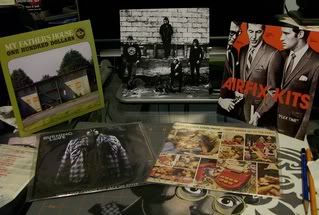
The EPs
Going clockwise from the top left, first one is
One Hundred Dollars- My Father's House
I watched a couple videos of this band live and decided I didn't like them. Then I heard one of their recordings and immediately placed this order.Carrying on the great tradition Canadian folk in the vein of Neil Young and Gordon Lightfoot, this EP is the second in some "regional 7" series", which I'm still a little in the dark about but from what I gather they're trying to put out 7"s in various regions of Canada, and this being on Deranged makes it southwestern British Columbia's contribution, a great idea if they can pull it off. And seeing as Canada doesn't have a redundant number of regions, and the fact that these are two song EPs, I feel like it will fair better than other similar projects that I've watched come to fruition only to fail before really making a dent and then claiming it was a farce (I'm calling you on your shit, Sufjan Stevens). As far as this EP goes musically, I'm totally enamoured by it. It makes me think of what it would have felt for me to be 19 in 1972 and picking up Neil Young's Harvest. There is no pretension here (I wouldn't fault you for expecting it, they are a folk group from Toronto in 2010), just two amazingly written and well refined songs. Straightforward through and through.
White Lung- Atlanta
Jumping from a Toronto to BC , here is something Vancouver's White Lung. A month ago almost to the day they played in a house around here and I was instantly blown away. Both by the fact that 3/4 of the band are ridiculously good looking (sorry other 1/4, but I'm sure you're a nice guy), and by the fact that they play great noisy frantic punk in a way that keeps up the great snotty twang that all good punk rock should have (both vocally and instrumentally) without crossing the line into stuff that's too frantic or too noisy, which is not my forte at all. It would be too easy for me to simply throw a "sounds sorta like Black Flag" on this band at leave it at that, but that would also be untrue. They certainly sound like something that has grown out of listening to a lot of 70s-80s LA punk rock, and while they certainly pay some dues to Black Flag with a Greg Ginnesque feeling of power and drive behind the song arrangements, that's pretty much where the comparison ends. The guitar work is phenomenal, totally outrageous lead guitar accompanied by frantic singing whizzing around over nothing but drums and bass for the three songs of pure energy. If you're into great guitar work that still fits nicely into the punk framework, with slight hints of surf buried deep in there somewhere, you'll totally love this. Only downside is the lack of a lyrics insert, what a bummer.
Airfix Kits- Flex Time
The second of two EPs from this Californian band,Airfix Kits and Flex Time take all the elements I love about bands like Wire and Shitty Limits and other twangy, snotty post-punk bands (I'm going to from this point on refer to them as Art-School-Punks, which I'll get to later in this review) and slows them down to be ever-so-slightly menacing ,the riff halfway through the first song of the B-side, 80s Aesthetic is a great example of this. But what they retain with the loss of speed is a sharp sense of intellect and satire in their songs, and you can tell not only through the lyrics, but also the vocals and the ways the songs play out. It's hard to put into words, but you'll understand it once you hear it. This along with the fact that much like The Shitty Limits, Airfix Kits really hit it out of the park with their record layout and cover design. Great clean lines everywhere, the insert is minimal and well organized, it just looks like something that cannot be accidentally accomplished with the help of a little punk-magic. This was an intentional effort. The combination of excellent humour and attention to minute details both in music but also in record design, lyrics and general aesthetic of a band are why from this point on I'm coining the term Art-School-Punk to refer to these bands and others like them. But who gives a shit what I'm calling it, this record is a must hear for everyone remotely interested in any facet of punk rock, even if it's just so you read the lyrics to 80s Aesthetic and get your head out of your ass.
Marvelous Darlings- I Don't Wanna Go To The Party b/w Careerist
No Warning starling Ben Cook is now the marvelous darling of this Toronto based power-pop foursome. I know, if you're reading this without actually hearing Marvelous Darlings, you are scratching your head somethin' fierce right now. And so was I until I heard this record. I really like No Warning, and I also REALLY LIKE power-pop so it's a wonder I didn't pick this up sooner. Both sides are insanely catchy, as I find myself flipping the record over and over again trying to get the opposite side's song out of my head. There are serious pop-song writing chops happening on both sides of this little record, and I'm not sure who to shower the praise on so I'll just soak the entire band instead, two song of pure gold just leave me wishing this was an LP, not an EP. A couple other observations to note, side B, Careerist, sounds a little like a song The Ergs would write, so if you like them check it out. Secondly, the insert thanks "C.C." for the design, who I'm assuming is Chris Colohan. So you know, if you liked Left For Dead, Ruination, The Swarm, Cursed, or Burning Love, I think you should just pick this up as well, for the sake of posterity. Thirdly and finally, I like this more than Ill Blood. There, I said it.
Burning Love- Don't Ever Change b/w Jack The Ripper
Speaking of Mr.Colohan, this is a single from his new band's recently released LP, Songs for Burning Lovers. The A-side appears in the same recording as on the album, but on the B-side we're treated to Jack The Ripper, a cover of the awesome Nick Cave tune. I'm not going to lie, I miss their Battalion of Saints cover, and I was told of a Thin Lizzy cover that never materialized (to my ears, anyway), but this more than redeems that. I've always loved this band because of the real ballsy full throttle sound they have going all the time, reminds me of Discharge with less "dum-tss-dumdum-tis" and more mild stoner influences. And, man, that Nick Cave cover. God damn it. Did I mention how good it was? cause it is.
It sounded good when it came out of Cave's mouth, and it sounds just as good coming from these guys, with a real thoroughly crushing sound on both sides of the record. I don't think this band can do any wrong. You should probably expect a review of the previously mentioned LP in the next couple of days if I get time. It's just as good as this. Order both, and go into either a pot or straight edge induced trance and enjoy.

The EPs
Going clockwise from the top left, first one is
One Hundred Dollars- My Father's House
I watched a couple videos of this band live and decided I didn't like them. Then I heard one of their recordings and immediately placed this order.Carrying on the great tradition Canadian folk in the vein of Neil Young and Gordon Lightfoot, this EP is the second in some "regional 7" series", which I'm still a little in the dark about but from what I gather they're trying to put out 7"s in various regions of Canada, and this being on Deranged makes it southwestern British Columbia's contribution, a great idea if they can pull it off. And seeing as Canada doesn't have a redundant number of regions, and the fact that these are two song EPs, I feel like it will fair better than other similar projects that I've watched come to fruition only to fail before really making a dent and then claiming it was a farce (I'm calling you on your shit, Sufjan Stevens). As far as this EP goes musically, I'm totally enamoured by it. It makes me think of what it would have felt for me to be 19 in 1972 and picking up Neil Young's Harvest. There is no pretension here (I wouldn't fault you for expecting it, they are a folk group from Toronto in 2010), just two amazingly written and well refined songs. Straightforward through and through.
White Lung- Atlanta
Jumping from a Toronto to BC , here is something Vancouver's White Lung. A month ago almost to the day they played in a house around here and I was instantly blown away. Both by the fact that 3/4 of the band are ridiculously good looking (sorry other 1/4, but I'm sure you're a nice guy), and by the fact that they play great noisy frantic punk in a way that keeps up the great snotty twang that all good punk rock should have (both vocally and instrumentally) without crossing the line into stuff that's too frantic or too noisy, which is not my forte at all. It would be too easy for me to simply throw a "sounds sorta like Black Flag" on this band at leave it at that, but that would also be untrue. They certainly sound like something that has grown out of listening to a lot of 70s-80s LA punk rock, and while they certainly pay some dues to Black Flag with a Greg Ginnesque feeling of power and drive behind the song arrangements, that's pretty much where the comparison ends. The guitar work is phenomenal, totally outrageous lead guitar accompanied by frantic singing whizzing around over nothing but drums and bass for the three songs of pure energy. If you're into great guitar work that still fits nicely into the punk framework, with slight hints of surf buried deep in there somewhere, you'll totally love this. Only downside is the lack of a lyrics insert, what a bummer.
Airfix Kits- Flex Time
The second of two EPs from this Californian band,Airfix Kits and Flex Time take all the elements I love about bands like Wire and Shitty Limits and other twangy, snotty post-punk bands (I'm going to from this point on refer to them as Art-School-Punks, which I'll get to later in this review) and slows them down to be ever-so-slightly menacing ,the riff halfway through the first song of the B-side, 80s Aesthetic is a great example of this. But what they retain with the loss of speed is a sharp sense of intellect and satire in their songs, and you can tell not only through the lyrics, but also the vocals and the ways the songs play out. It's hard to put into words, but you'll understand it once you hear it. This along with the fact that much like The Shitty Limits, Airfix Kits really hit it out of the park with their record layout and cover design. Great clean lines everywhere, the insert is minimal and well organized, it just looks like something that cannot be accidentally accomplished with the help of a little punk-magic. This was an intentional effort. The combination of excellent humour and attention to minute details both in music but also in record design, lyrics and general aesthetic of a band are why from this point on I'm coining the term Art-School-Punk to refer to these bands and others like them. But who gives a shit what I'm calling it, this record is a must hear for everyone remotely interested in any facet of punk rock, even if it's just so you read the lyrics to 80s Aesthetic and get your head out of your ass.
Marvelous Darlings- I Don't Wanna Go To The Party b/w Careerist
No Warning starling Ben Cook is now the marvelous darling of this Toronto based power-pop foursome. I know, if you're reading this without actually hearing Marvelous Darlings, you are scratching your head somethin' fierce right now. And so was I until I heard this record. I really like No Warning, and I also REALLY LIKE power-pop so it's a wonder I didn't pick this up sooner. Both sides are insanely catchy, as I find myself flipping the record over and over again trying to get the opposite side's song out of my head. There are serious pop-song writing chops happening on both sides of this little record, and I'm not sure who to shower the praise on so I'll just soak the entire band instead, two song of pure gold just leave me wishing this was an LP, not an EP. A couple other observations to note, side B, Careerist, sounds a little like a song The Ergs would write, so if you like them check it out. Secondly, the insert thanks "C.C." for the design, who I'm assuming is Chris Colohan. So you know, if you liked Left For Dead, Ruination, The Swarm, Cursed, or Burning Love, I think you should just pick this up as well, for the sake of posterity. Thirdly and finally, I like this more than Ill Blood. There, I said it.
Burning Love- Don't Ever Change b/w Jack The Ripper
Speaking of Mr.Colohan, this is a single from his new band's recently released LP, Songs for Burning Lovers. The A-side appears in the same recording as on the album, but on the B-side we're treated to Jack The Ripper, a cover of the awesome Nick Cave tune. I'm not going to lie, I miss their Battalion of Saints cover, and I was told of a Thin Lizzy cover that never materialized (to my ears, anyway), but this more than redeems that. I've always loved this band because of the real ballsy full throttle sound they have going all the time, reminds me of Discharge with less "dum-tss-dumdum-tis" and more mild stoner influences. And, man, that Nick Cave cover. God damn it. Did I mention how good it was? cause it is.
I GOT A WOMAN AND SHE STRIKES ME DOWN WITH A FIST OF LEAD
It sounded good when it came out of Cave's mouth, and it sounds just as good coming from these guys, with a real thoroughly crushing sound on both sides of the record. I don't think this band can do any wrong. You should probably expect a review of the previously mentioned LP in the next couple of days if I get time. It's just as good as this. Order both, and go into either a pot or straight edge induced trance and enjoy.
Saturday, July 17, 2010

Mom, is it ok to fight if your trying to save someone?
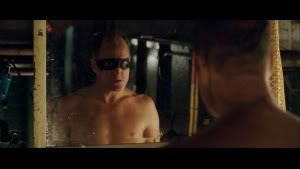

Peter Stebbings' Defendor
The trailer for this one real misleading, the movie is taken more seriously than the trailer represents, so don't let it trick you. If you want to see Woody Harrelson play a mentally delayed man who thinks he's a superhero (trust me, you do!), there is no reason not to watch this.
Plus it's set in Hamilton, how cool is that?
And as a final side note, much like You Might As Well Live, this has Clark Johnson in a minor role. Trust my nerd sensibilities to pick up on these things.

I can't think of the last time I was so simultaneously intrigued/impressed/dumbfounded/angry about anyone's writing. Maybe when I first read Animal Farm in grade 9, MAYBE.
I'll cover this in more detail with my next book review post, but if you're into reading essays/philosophy stuff and also into being mild-strongly offended, check out Arthur Schopenhauer.
Friday, July 16, 2010
As petty as this is, I rack my head about this every time I listen to Black Flag.
WHO WAS THE BEST SINGER?
Right now my thinking goes as follows...
1ST PLACE

Chavo Pederast
Top Performance- No Values from the Jealous Again EP
Jealous Again is easily my top Black Flag record, mainly because Chavo (or Ron Reyes, if you prefer) had the best voice in punk, ever. This is just the standout track for me (by a HAIR). Too bad dude couldn't get his shit together and stick around with the band. All the way through, perfect balance of clarity, snottiness, and what can only be described as a sheer ballsy voice.
2ND PLACE

Dez Cadena
Top Performance-
Six Pack from the Six Pack EP.
The period with Dez on vocals was unfortunate, he had a real rough voice (similar to Henry Rollins', who would follow) but due to the band making the jump from punk rock four piece to a more experimental five piece, Dez offered to relocate himself to second guitar before he really had many chances to expand on his vocals. The only reason he ranks lower than Chavo is that he doesn't have the same snotty/harsh balance that really makes Chavo stand out, but he's got the ballsy bark down real well, that's for sure. And Six Pack highlights that, with one of the more creative vocal patterns of his unfortunately few (six, to be exact) recorded songs. If he had the same time Rollins did to mature, I'm sure he would have been a better choice as a long term vocalist.
3RD PLACE

Henry Rollins
Top Performance-
Wound Up Slip It In
The posterboy for Black Flag, Rollins had the longest tenure in the band (other than Greg Ginn himself, that is) and while I don't think there's anything inherently bad about his voice, it becomes crystal clear that as soon as he joined the band Greg Ginn decided that the focus should be relocated to the song structure and riffs rather than a hyper energetic front man. And that it did, the songs with Rollins on mic are amazing, but not entirely because of him. He was in the band, and he did what was told (and did it damn well, mind you) but lacked what both Chavo and Dez brought forward. But there are still a couple songs where the song owes more to Rollins' performance, Wound Up being one of those tracks. I get so wouuuuuuuUUUUUUUUUUUUUUUNNNNNNNNND UP!/ To feel so let down.. Brilliant vocals right there.
4TH PLACE

Keith Morris
Top Performance-
I've Had It from the Nervous Breakdown EP.
My big problem with Morris is that he all to often sang really clean, and especially after hearing him let loose on this track (and later with The Circle Jerks) I just can't justify anything but an honourable fourth place.
Seriously, that chorus, damn.
WHO WAS THE BEST SINGER?
Right now my thinking goes as follows...
1ST PLACE

Chavo Pederast
Top Performance- No Values from the Jealous Again EP
Jealous Again is easily my top Black Flag record, mainly because Chavo (or Ron Reyes, if you prefer) had the best voice in punk, ever. This is just the standout track for me (by a HAIR). Too bad dude couldn't get his shit together and stick around with the band. All the way through, perfect balance of clarity, snottiness, and what can only be described as a sheer ballsy voice.
2ND PLACE

Dez Cadena
Top Performance-
Six Pack from the Six Pack EP.
The period with Dez on vocals was unfortunate, he had a real rough voice (similar to Henry Rollins', who would follow) but due to the band making the jump from punk rock four piece to a more experimental five piece, Dez offered to relocate himself to second guitar before he really had many chances to expand on his vocals. The only reason he ranks lower than Chavo is that he doesn't have the same snotty/harsh balance that really makes Chavo stand out, but he's got the ballsy bark down real well, that's for sure. And Six Pack highlights that, with one of the more creative vocal patterns of his unfortunately few (six, to be exact) recorded songs. If he had the same time Rollins did to mature, I'm sure he would have been a better choice as a long term vocalist.
3RD PLACE

Henry Rollins
Top Performance-
Wound Up Slip It In
The posterboy for Black Flag, Rollins had the longest tenure in the band (other than Greg Ginn himself, that is) and while I don't think there's anything inherently bad about his voice, it becomes crystal clear that as soon as he joined the band Greg Ginn decided that the focus should be relocated to the song structure and riffs rather than a hyper energetic front man. And that it did, the songs with Rollins on mic are amazing, but not entirely because of him. He was in the band, and he did what was told (and did it damn well, mind you) but lacked what both Chavo and Dez brought forward. But there are still a couple songs where the song owes more to Rollins' performance, Wound Up being one of those tracks. I get so wouuuuuuuUUUUUUUUUUUUUUUNNNNNNNNND UP!/ To feel so let down.. Brilliant vocals right there.
4TH PLACE

Keith Morris
Top Performance-
I've Had It from the Nervous Breakdown EP.
My big problem with Morris is that he all to often sang really clean, and especially after hearing him let loose on this track (and later with The Circle Jerks) I just can't justify anything but an honourable fourth place.
Seriously, that chorus, damn.
Thursday, July 15, 2010
Tuesday, July 13, 2010
Thursday, July 8, 2010
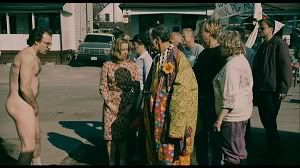

Simon Ennis' You Might As Well Live
Not much to say about this other than that Robert Mutt is......well, he's Robert Mutt.
Oh and it was really good!
Wednesday, July 7, 2010
Monday, July 5, 2010
Here we go with some more book reviews or stuff I read in the past week. 15 in total, organized by size of the book. Wish me luck!
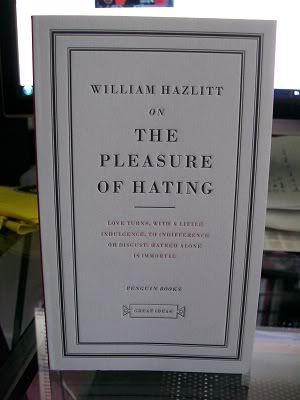
A post like this wouldn't be complete without at least one volume of Penguin's Great Ideas series, so here's a collection of essays by English writer William Hazlitt, titled On The Pleasure Of Hating. This is a nice change from the volumes that came previous int he sense that Hazlitt has a great personal style of writing, and I feel that this volume focuses less on the ideas he is presenting (as opposed to say, Wollstonecraft or Paine) but rather on the distinctive personal style of his writing.
The final essay in the collection, On The Pleasure Of Hating is easily the standout of the half dozen packed into this 120 page paperback. In which Hazlitt comes to the sobering conclusion that love and hate are necessarily connected, in the sense that at one point or another, love will certainly turn against itself. He concludes his thoughts by reflecting on the fact that he is "always disappointed where I placed most reliance; the dupe of friendship, and the fool of love; have I not reason to hate and to despise myself? Indeed I do; and chiefly for not having hated and despised the world enough."
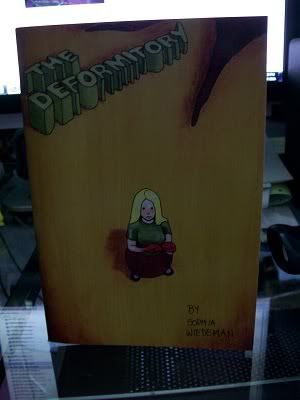
Keeping in the realm of self-loathing, this is a short graphic novel by Sophia Wiedeman titled The Deformitory. Telling the story of Dolores (along with a couple other minor characters) who struggle to establish any sort of interpersonal relationships, and due to the fact that they all share physical deformities they end up residing in a tower on an island after which the book is titled. And I'm not talking one foot smaller than the other sorta deformities, I'm talking lobster hands and mermaids with the lower torso of a slug. Even if you've never woken up to find yourself half-man-half-beast, the general theme is something real easy to relate to assuming you grew up in anything short of an episode of Leave it to Beaver.
Upon reading and further investigation I found out that this book was submitted as Wiedeman's graduate thesis project, and while I'm not exactly on the fast track to getting a MFA, I think it fucking rules that a comic can be considered a valid project. I mean, she has the degree now, so it must count, right?
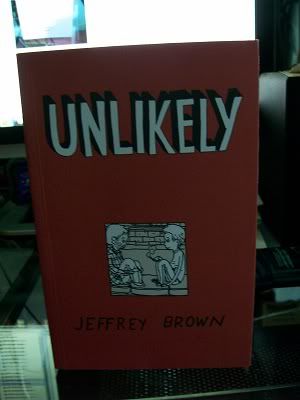
Graphic novel number two is Jeffery Brown's Unlikely, telling the story of how he awkwardly went about losing his virginity and the fallout of breaking up with his girlfriend of that time after the fact. Generally, I shy away from autobiographical books of any sort (comic or not) so I think I surprised myself a little by picking this one up on a whim.
I'm still not entirely sure how I feel about it, it was a good read in the sense of being able to watch Jeff's cycle of success/failure/success/more failure/end through out the relationship and the connection was there but I couldn't and still can't really put my finger on what exactly made it possible for this book to keep my interest enough for me to read it in a single sitting and actually enjoy it. I imagine it's enjoyable because it's a real basic everyman story and manages to capture the unpredictability of life perfectly because well, it was life, at some point.
I'm debating whether or not to pick up any of Brown's other books (this is apparently the second installment of what has been dubbed the "Girlfriend Trilogy". We'll see...
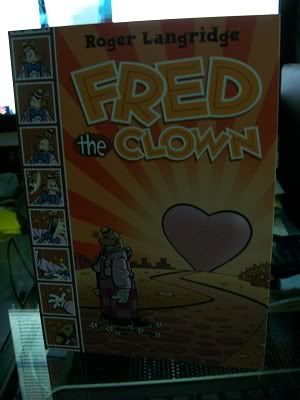
From super realistic to totally unbelievable, here's Roger Langridge's Fred the Clown. With a focus on the entirely absurd, Langridge presents Fred, a clown who is trying as hard as he can to make it through life and find a woman, but just can't keep ahead. In regards to Lapp's Children of the Atom I mentioned reading a review in which he was compared to Samuel Beckett, and in this review I'm going to put forward the idea that Fred the Clown is three quarters Charlie Chaplin, and one quarter Beckett.
Fred has a character much like Homer Simpson (another whom I would give the Chaplin/Beckett comparison), in that he lands in a gray area between reality and the absurd. While most of the time he fits the role of being totally unbelievable, at other times it's entirely possible to look at a situation in which Fred has found himself and see an entirely normal person standing there.
Langridge does an amazing job of writing excellent gag comics, and has a cartooning style that manages to hold not a single main joke in each strip, but often many smaller ones at the same time. A great read for anyone interested in "funny" comics.
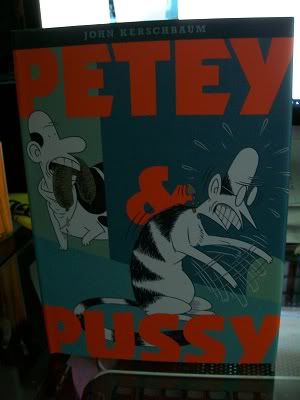
I think I picked up Petey & Pussy because subconsciously the title made me giggle immaturely, or something. On that note, that's about as uproarious as my laughter got when I was reading through this. I'm sorry John Kerschbaum but maybe something about you just isn't "my thing" or whatever, even though I do like his online comics.
Chronicling the misadventures of dog and cat duo Petey and Pussy, Kerschbaum takes it one step beyond a typical Garfield & Odie affair by giving the Pussy and his canine pal human heads, middle aged male heads with serious baldness going on to be more specific. Not only that, but the two quickly become flooded in a sea of innuendo and toilet humour, which is funny sometimes but just not really something that keeps me laughing for 126 pages.
I'm not really sure what I was expecting with this one, because I can't even really relate it to any specific expectations. If this sounds like something you'd be into though, you might as well check it out. Just cause it isn't my thing doesn't mean it won't be yours.....maybe.
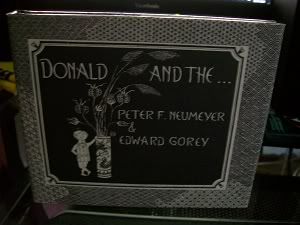
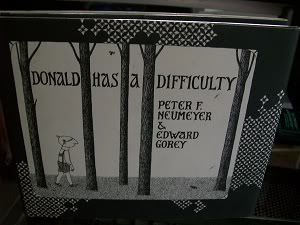
Already showing signs of fatigue, I'm going to review these two awesome books by author Peter F Neumeyer and illustrator Edward Gorey together, because they're both part of the three childrens books Neumeyer and Gorey created together (The third, Why We Have Day and Night is apparently out of print and hard to get a hold of). Luckily these two are still in print, here's Donald Has A Difficulty and Donald And The....
I had been meaning to actually pick up some books illustrated by Edward Gorey for a long time, and after seeing these in a discount book store with a friend I really had no reason not to snatch them up. The good news, I love them. The bad, this means I'll probably be tracking down more of his books (including Why We Have Day and Night) and crying as they empty my poor bank account.
Donald Has A Difficulty tells the tale of poor Donald as he deals with a splinter, and the painful process of removing it and sterilizing the wound. However, it's written in a way that the entire story is slightly off putting, never sure what will become of poor Donald on the next pages. Meanwhile, Donald And The..., my personal favourite, sees Donald and his mother taking a worm of some sort out of a garbage can and observing as Donald watches it transform first into a cocoon and then finally a....well, I won't spoil that bit for you.
In both cases, not only is Gorey's illustration outstanding in an eerie way but it's also clear that much of the reason these books are so enjoyable is due to the great way that the writing and illustrations compliment each other. I look forward to reading some of Gorey's work in which he serves as both writer and illustrator. Apparently it gets weird, and I like weird.
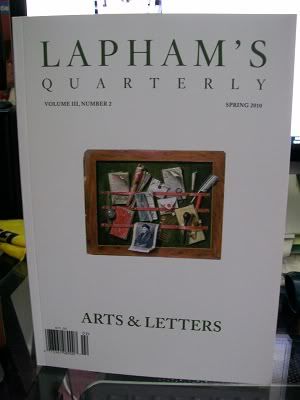
Taking a total shift, this is the second issue of the third volume of Lapham's Quarterly, a magazine by former Harper's editor Lewis H. Lapham. The series functions by having each issue based around a central theme (In this case, Arts & Letters) and supporting it with what can only be described as as whole ton of contributions not only by historical figures, but also by contemporary figures. To put it into perspective, the back cover boasts that some of the contributors to this issue alone are "Van Gogh, Barrett-Browning, Wagner, Vonnegut, Suetonius, Warhol, Armstrong, James, Juvenal, Horave, Bolano, Hamsun, Pushkin, Rushdie and Steiner". With a span of over 2000 years behind the contributions, that's alot to work with.
At first I was impressed by the idea, and then as I started becoming weary about how well it would flow together. However, in the end I was incredibly impressed by how it all came together. This is a great read for anyone with an interest in assorted facts (as I am), or in history (as I am). Also, this issue in particular is great in the sense that it often puts each individual's creative processes into a really concise chunk of text, and as you read you'll get great insights into the lives of everyone from Plato to Hitler, with short letters or correspondences that are often overlooked in favor of their more important work. A great magazine that still feels less like a magazine and more like a book that could stand on its own two feet.
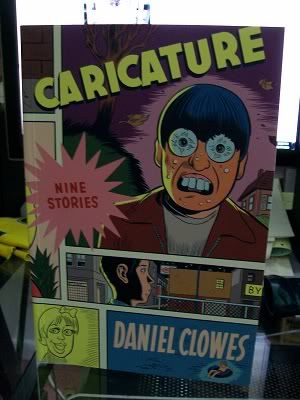
Back to graphic novel-dom with Caricature, a collection of nine short stories by award winning Daniel Clowes. I'll just put out there that I don't think Daniel Clowes has the capability of creating anything that I won't enjoy, so if you're waiting for me to say something bad about this collection, keep on walkin. All but one of these stories (the exception being Green Eyeliner) were originally published in his comic book series Eightball, which is also known for Ghost World, Like A Velvet Glove Cast In Iron, among even more outstanding titles.
All of the stories generally deal with some sort of societal deviance with a strong sense of naturalism as Clowes focuses of the day-to-day often mundane lives of his otherwise eccentric group of characters. With stories covering everything from the mental decline of a caricature artist, to a loner kid forced to live with his grandparents, and even stories involving a gynecologist and a superhero, there is no shortage of suspense, shocks, or entertainment provided in only 101 pages. Of course, it also doesn't hurt that Clowes is also an entirely stellar artist.
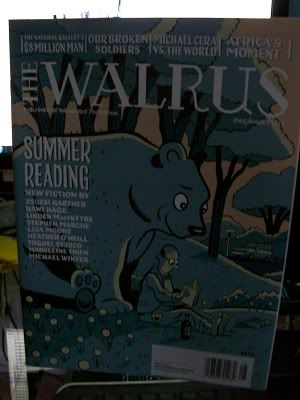
I read a list of recommended Canadian Magazines that I thought that I should be checking out, and The Walrus was one of them, and I jumped in head first at Vol.7 No.6. Before I begin, I'm going to get some comic nerdery out of the way, the cover and many illustrations throughout were done by the amazing Guelph, Ontario artist Seth. Furthermore, many of the other illustrations in this issue were by Ginette Lapalme, a member of the Toronto, Ontario comic collective Wowee Zonk. It's great to see this sort of thing popping up in places like this!
Anyway, now that I've taken care of that I'll get into how much the rest of this magazine rules. Firstly, it's got that perfect Magazine length that I mentioned in another post, with the page count sitting at 81 including ads, The Walrus features 13 pieces ranging from a critique of the Canadian critical culture (something I'm not very knowledgeable about, but was interesting anyway) to a story of how Ghana managed to claw its way out of post-colonial struggles, surpassing most of the continent. This span of so many different subjects in what is really a relatively short amount of spaces makes for exactly what a magazine should be, low on the quantity scale by sky high when it comes to quality. This was good enough that I am actually temped to subscribe, rather than picking it up at my local bookstore, and that thought rarely if ever crosses my mind for most magazines.
As a sidenote, there is also an excellent group of Canadian-penned short stories included which I probably would have considered picking up even if it had been in no way related to this magazine, great stuff.

From a magazine that I can't wait to read more of, to a magazine that I doubt I'll be picking up anytime soon, it's time for. Utne Reader. This issue piqued my attention because of the "72 Award-Winning Magazine You Will Love" line across the top of the cover, so I figured "why not" and picked it up. While I do have to give it credit for introducing me to both The Walrus and Geist (see next review), that's pretty much where my praise ends.
Utne works by harvesting articles from all sorts of magazines (12,000 publications, to be exact) and cherry picking what they see as the best articles to include in each bi-monthly issue. While I like the idea of what they're doing, it doesn't work out so well. The articles themselves aren't bad, but the way they cram so many (20 articles plus dispatches into 96 pages) makes it feel almost laborious to read through, and in the case of the great articles (in this case, the cover article about the realatively boring day-to-day events of a couple Al-Qaeda which showed them cooking eggs, for example.) I'd rather just read that in the original magazine, maybe I'm just a magazine puritan or something.
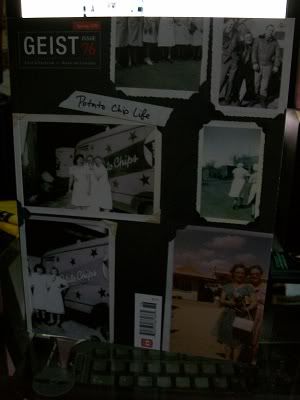
Praise Jah that reading Utne eventually lead me to Geist, an amazing Canadian collection of primarily fiction, but also some short non-fiction pieces as well. Not to mention that it is laid out amazingly, with minimal pictures (mainly black and white) with real simple line breaks dividing pieces.
Personal favourite articles included Memory Arranger, which tells the story of Faith Moosang finding a photo album of women who used to work at a potato chip factory years ago (during WWII) and piecing together a history of sorts around them. Sound good? well, remember that it's a non-fiction piece as well and it gets even better. Also, Bruce McDougal's Talent Night the terribly depressing story of a father son relationship, I'd explain more but the surprise is what makes the story.
Another great Canadian magazine full of equally great Canadian content, I'll be sure to keep up with this one as well.
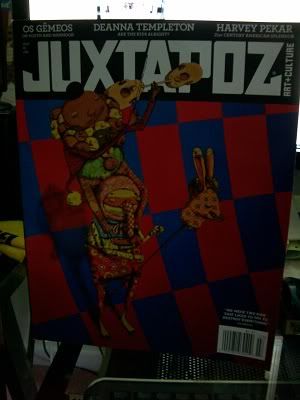
Coming into the final stretch of this reviewathon, it's time for my first issue of "Art+ Culture" magazine Juxtapoz with issue no. 113.
I had always looked at this magazine a little apprehensively, because to be honest I thought it would either be a little too much over my head in terms of content or it would just be stuff I thought I might find to be a little lame. I'm glad I was wrong on both accounts. Primarily image based (as a magazine like this should be), I quickly found my self unable to put this down, I was reading it on break at work and "accidentally" forgot to finish break on time, whoops. I can't think of anything I didn't really enjoy about this magazine, and I was really excited as I made my way through the interviews (Especially with the duo Os Gemeos, computer wizard Robert Hodgin and former Vancouverite Richard Hambleton) and as soon as I finished each piece I would rush to the barren wastes of the internet to try and scrounge up whatever extra info I could find.
I'm probably so excited because I'm diving into an area in which I have very little experience with and I love being surrounded by things that are so new and alien to me. Maybe that feeling will wear away with future issues, but I hope not.
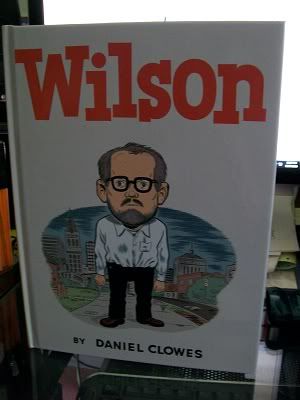
The final graphic novel of this set of books (I PROMISE!) and I'm coming back to Daniel Clowes again with his most recent book, Wilson. With this novel it's easy to see Clowes absolutely perfecting the sort of character based story he was becoming more comfortable with in the stories of Caricature. According to the back cover, Wilson is "A big-hearted slob, a lonesome bachelor, a devoted father and husband, an idiot, a sociopath, a delusional blowhard, a delicate flower and 100% Wilsonesque". I don't think I can sum it up any better than that.
Part heart breaking but mainly embarrassing, Wilson is in panic mode as he tries to scrape his life back together, including a long lost daughter, an ex-wife and a dog. What this turns into can't be described here, you'll just have to pick this up and read it yourself. I feel like this is what might happen if Milton of Office Space fame grew a pair and became a sociopath in comic form, and we all know he's the best part of that movie.
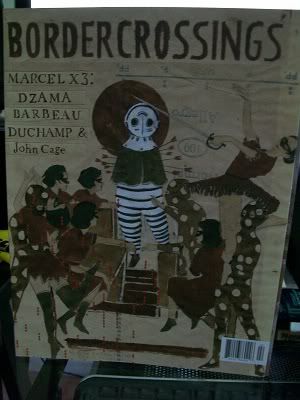
I was doing some birthday shopping for a friend when I noticed this magazine sitting on the magazine rack across the room. I had known how interested she was in at least two of the Marcel triplets mentioned on the cover (Dzama and Duchamp, I'm not sure about Barbeau) and after looking at it for a while I had decided to pick up two copies, one as part of said gift and one for myself. I mean, what's not to like? aritcles that seemed great at a quick glance, great images and another magazine published in Canada. Bordercrossings Vol.29 Issue 2 was a win/win/win/win/win situation.
My instinct didn't fail me, and as I mentioned with Juxtapoz, I was totally enamored with the idea of reading about something that I had no real knowledge about and learning so much from just over 100 pages. However, while I learned that Juxtapoz was primarily image based with less emphasis on the theoretical half of art, Bordercrossings sits in the middle, having a happy balance of the two. I was pleased with this because despite some parts seeming a little bit dense (it took me a couple reads of some articles to grasp them, I'll admit it) I doubt I would have enjoyed this as much had it not been slightly challenging.
Perhaps the highlight of reading it was the piece with/about Quebec artist Marcel Barbeau, and more specifically the fact that it opened my eyes to Le Refus Global, an organization that was not only controversial and important, but also distinctly Canadian. I can't believe that I had never heard about this before, especially considering the major role in played in Quebec society and French Canadian relations.
I feel like I could keep going and listing all of the awesome things that this single magazine opened my eyes to, but I'll stop and leave it at the fact that if you pick this up, you WILL be impressed, you WILL learn something and you WILL be a better person because of it. $9.95 is a small price to pay for that.
I can't believe I just wrote all that in two days time, next time I need to balance my reading/reviewing out more evenly, goddamn.

A post like this wouldn't be complete without at least one volume of Penguin's Great Ideas series, so here's a collection of essays by English writer William Hazlitt, titled On The Pleasure Of Hating. This is a nice change from the volumes that came previous int he sense that Hazlitt has a great personal style of writing, and I feel that this volume focuses less on the ideas he is presenting (as opposed to say, Wollstonecraft or Paine) but rather on the distinctive personal style of his writing.
The final essay in the collection, On The Pleasure Of Hating is easily the standout of the half dozen packed into this 120 page paperback. In which Hazlitt comes to the sobering conclusion that love and hate are necessarily connected, in the sense that at one point or another, love will certainly turn against itself. He concludes his thoughts by reflecting on the fact that he is "always disappointed where I placed most reliance; the dupe of friendship, and the fool of love; have I not reason to hate and to despise myself? Indeed I do; and chiefly for not having hated and despised the world enough."

Keeping in the realm of self-loathing, this is a short graphic novel by Sophia Wiedeman titled The Deformitory. Telling the story of Dolores (along with a couple other minor characters) who struggle to establish any sort of interpersonal relationships, and due to the fact that they all share physical deformities they end up residing in a tower on an island after which the book is titled. And I'm not talking one foot smaller than the other sorta deformities, I'm talking lobster hands and mermaids with the lower torso of a slug. Even if you've never woken up to find yourself half-man-half-beast, the general theme is something real easy to relate to assuming you grew up in anything short of an episode of Leave it to Beaver.
Upon reading and further investigation I found out that this book was submitted as Wiedeman's graduate thesis project, and while I'm not exactly on the fast track to getting a MFA, I think it fucking rules that a comic can be considered a valid project. I mean, she has the degree now, so it must count, right?

Graphic novel number two is Jeffery Brown's Unlikely, telling the story of how he awkwardly went about losing his virginity and the fallout of breaking up with his girlfriend of that time after the fact. Generally, I shy away from autobiographical books of any sort (comic or not) so I think I surprised myself a little by picking this one up on a whim.
I'm still not entirely sure how I feel about it, it was a good read in the sense of being able to watch Jeff's cycle of success/failure/success/more failure/end through out the relationship and the connection was there but I couldn't and still can't really put my finger on what exactly made it possible for this book to keep my interest enough for me to read it in a single sitting and actually enjoy it. I imagine it's enjoyable because it's a real basic everyman story and manages to capture the unpredictability of life perfectly because well, it was life, at some point.
I'm debating whether or not to pick up any of Brown's other books (this is apparently the second installment of what has been dubbed the "Girlfriend Trilogy". We'll see...

From super realistic to totally unbelievable, here's Roger Langridge's Fred the Clown. With a focus on the entirely absurd, Langridge presents Fred, a clown who is trying as hard as he can to make it through life and find a woman, but just can't keep ahead. In regards to Lapp's Children of the Atom I mentioned reading a review in which he was compared to Samuel Beckett, and in this review I'm going to put forward the idea that Fred the Clown is three quarters Charlie Chaplin, and one quarter Beckett.
Fred has a character much like Homer Simpson (another whom I would give the Chaplin/Beckett comparison), in that he lands in a gray area between reality and the absurd. While most of the time he fits the role of being totally unbelievable, at other times it's entirely possible to look at a situation in which Fred has found himself and see an entirely normal person standing there.
Langridge does an amazing job of writing excellent gag comics, and has a cartooning style that manages to hold not a single main joke in each strip, but often many smaller ones at the same time. A great read for anyone interested in "funny" comics.

I think I picked up Petey & Pussy because subconsciously the title made me giggle immaturely, or something. On that note, that's about as uproarious as my laughter got when I was reading through this. I'm sorry John Kerschbaum but maybe something about you just isn't "my thing" or whatever, even though I do like his online comics.
Chronicling the misadventures of dog and cat duo Petey and Pussy, Kerschbaum takes it one step beyond a typical Garfield & Odie affair by giving the Pussy and his canine pal human heads, middle aged male heads with serious baldness going on to be more specific. Not only that, but the two quickly become flooded in a sea of innuendo and toilet humour, which is funny sometimes but just not really something that keeps me laughing for 126 pages.
I'm not really sure what I was expecting with this one, because I can't even really relate it to any specific expectations. If this sounds like something you'd be into though, you might as well check it out. Just cause it isn't my thing doesn't mean it won't be yours.....maybe.


Already showing signs of fatigue, I'm going to review these two awesome books by author Peter F Neumeyer and illustrator Edward Gorey together, because they're both part of the three childrens books Neumeyer and Gorey created together (The third, Why We Have Day and Night is apparently out of print and hard to get a hold of). Luckily these two are still in print, here's Donald Has A Difficulty and Donald And The....
I had been meaning to actually pick up some books illustrated by Edward Gorey for a long time, and after seeing these in a discount book store with a friend I really had no reason not to snatch them up. The good news, I love them. The bad, this means I'll probably be tracking down more of his books (including Why We Have Day and Night) and crying as they empty my poor bank account.
Donald Has A Difficulty tells the tale of poor Donald as he deals with a splinter, and the painful process of removing it and sterilizing the wound. However, it's written in a way that the entire story is slightly off putting, never sure what will become of poor Donald on the next pages. Meanwhile, Donald And The..., my personal favourite, sees Donald and his mother taking a worm of some sort out of a garbage can and observing as Donald watches it transform first into a cocoon and then finally a....well, I won't spoil that bit for you.
In both cases, not only is Gorey's illustration outstanding in an eerie way but it's also clear that much of the reason these books are so enjoyable is due to the great way that the writing and illustrations compliment each other. I look forward to reading some of Gorey's work in which he serves as both writer and illustrator. Apparently it gets weird, and I like weird.

Taking a total shift, this is the second issue of the third volume of Lapham's Quarterly, a magazine by former Harper's editor Lewis H. Lapham. The series functions by having each issue based around a central theme (In this case, Arts & Letters) and supporting it with what can only be described as as whole ton of contributions not only by historical figures, but also by contemporary figures. To put it into perspective, the back cover boasts that some of the contributors to this issue alone are "Van Gogh, Barrett-Browning, Wagner, Vonnegut, Suetonius, Warhol, Armstrong, James, Juvenal, Horave, Bolano, Hamsun, Pushkin, Rushdie and Steiner". With a span of over 2000 years behind the contributions, that's alot to work with.
At first I was impressed by the idea, and then as I started becoming weary about how well it would flow together. However, in the end I was incredibly impressed by how it all came together. This is a great read for anyone with an interest in assorted facts (as I am), or in history (as I am). Also, this issue in particular is great in the sense that it often puts each individual's creative processes into a really concise chunk of text, and as you read you'll get great insights into the lives of everyone from Plato to Hitler, with short letters or correspondences that are often overlooked in favor of their more important work. A great magazine that still feels less like a magazine and more like a book that could stand on its own two feet.

Back to graphic novel-dom with Caricature, a collection of nine short stories by award winning Daniel Clowes. I'll just put out there that I don't think Daniel Clowes has the capability of creating anything that I won't enjoy, so if you're waiting for me to say something bad about this collection, keep on walkin. All but one of these stories (the exception being Green Eyeliner) were originally published in his comic book series Eightball, which is also known for Ghost World, Like A Velvet Glove Cast In Iron, among even more outstanding titles.
All of the stories generally deal with some sort of societal deviance with a strong sense of naturalism as Clowes focuses of the day-to-day often mundane lives of his otherwise eccentric group of characters. With stories covering everything from the mental decline of a caricature artist, to a loner kid forced to live with his grandparents, and even stories involving a gynecologist and a superhero, there is no shortage of suspense, shocks, or entertainment provided in only 101 pages. Of course, it also doesn't hurt that Clowes is also an entirely stellar artist.

I read a list of recommended Canadian Magazines that I thought that I should be checking out, and The Walrus was one of them, and I jumped in head first at Vol.7 No.6. Before I begin, I'm going to get some comic nerdery out of the way, the cover and many illustrations throughout were done by the amazing Guelph, Ontario artist Seth. Furthermore, many of the other illustrations in this issue were by Ginette Lapalme, a member of the Toronto, Ontario comic collective Wowee Zonk. It's great to see this sort of thing popping up in places like this!
Anyway, now that I've taken care of that I'll get into how much the rest of this magazine rules. Firstly, it's got that perfect Magazine length that I mentioned in another post, with the page count sitting at 81 including ads, The Walrus features 13 pieces ranging from a critique of the Canadian critical culture (something I'm not very knowledgeable about, but was interesting anyway) to a story of how Ghana managed to claw its way out of post-colonial struggles, surpassing most of the continent. This span of so many different subjects in what is really a relatively short amount of spaces makes for exactly what a magazine should be, low on the quantity scale by sky high when it comes to quality. This was good enough that I am actually temped to subscribe, rather than picking it up at my local bookstore, and that thought rarely if ever crosses my mind for most magazines.
As a sidenote, there is also an excellent group of Canadian-penned short stories included which I probably would have considered picking up even if it had been in no way related to this magazine, great stuff.

From a magazine that I can't wait to read more of, to a magazine that I doubt I'll be picking up anytime soon, it's time for. Utne Reader. This issue piqued my attention because of the "72 Award-Winning Magazine You Will Love" line across the top of the cover, so I figured "why not" and picked it up. While I do have to give it credit for introducing me to both The Walrus and Geist (see next review), that's pretty much where my praise ends.
Utne works by harvesting articles from all sorts of magazines (12,000 publications, to be exact) and cherry picking what they see as the best articles to include in each bi-monthly issue. While I like the idea of what they're doing, it doesn't work out so well. The articles themselves aren't bad, but the way they cram so many (20 articles plus dispatches into 96 pages) makes it feel almost laborious to read through, and in the case of the great articles (in this case, the cover article about the realatively boring day-to-day events of a couple Al-Qaeda which showed them cooking eggs, for example.) I'd rather just read that in the original magazine, maybe I'm just a magazine puritan or something.

Praise Jah that reading Utne eventually lead me to Geist, an amazing Canadian collection of primarily fiction, but also some short non-fiction pieces as well. Not to mention that it is laid out amazingly, with minimal pictures (mainly black and white) with real simple line breaks dividing pieces.
Personal favourite articles included Memory Arranger, which tells the story of Faith Moosang finding a photo album of women who used to work at a potato chip factory years ago (during WWII) and piecing together a history of sorts around them. Sound good? well, remember that it's a non-fiction piece as well and it gets even better. Also, Bruce McDougal's Talent Night the terribly depressing story of a father son relationship, I'd explain more but the surprise is what makes the story.
Another great Canadian magazine full of equally great Canadian content, I'll be sure to keep up with this one as well.

Coming into the final stretch of this reviewathon, it's time for my first issue of "Art+ Culture" magazine Juxtapoz with issue no. 113.
I had always looked at this magazine a little apprehensively, because to be honest I thought it would either be a little too much over my head in terms of content or it would just be stuff I thought I might find to be a little lame. I'm glad I was wrong on both accounts. Primarily image based (as a magazine like this should be), I quickly found my self unable to put this down, I was reading it on break at work and "accidentally" forgot to finish break on time, whoops. I can't think of anything I didn't really enjoy about this magazine, and I was really excited as I made my way through the interviews (Especially with the duo Os Gemeos, computer wizard Robert Hodgin and former Vancouverite Richard Hambleton) and as soon as I finished each piece I would rush to the barren wastes of the internet to try and scrounge up whatever extra info I could find.
I'm probably so excited because I'm diving into an area in which I have very little experience with and I love being surrounded by things that are so new and alien to me. Maybe that feeling will wear away with future issues, but I hope not.

The final graphic novel of this set of books (I PROMISE!) and I'm coming back to Daniel Clowes again with his most recent book, Wilson. With this novel it's easy to see Clowes absolutely perfecting the sort of character based story he was becoming more comfortable with in the stories of Caricature. According to the back cover, Wilson is "A big-hearted slob, a lonesome bachelor, a devoted father and husband, an idiot, a sociopath, a delusional blowhard, a delicate flower and 100% Wilsonesque". I don't think I can sum it up any better than that.
Part heart breaking but mainly embarrassing, Wilson is in panic mode as he tries to scrape his life back together, including a long lost daughter, an ex-wife and a dog. What this turns into can't be described here, you'll just have to pick this up and read it yourself. I feel like this is what might happen if Milton of Office Space fame grew a pair and became a sociopath in comic form, and we all know he's the best part of that movie.

I was doing some birthday shopping for a friend when I noticed this magazine sitting on the magazine rack across the room. I had known how interested she was in at least two of the Marcel triplets mentioned on the cover (Dzama and Duchamp, I'm not sure about Barbeau) and after looking at it for a while I had decided to pick up two copies, one as part of said gift and one for myself. I mean, what's not to like? aritcles that seemed great at a quick glance, great images and another magazine published in Canada. Bordercrossings Vol.29 Issue 2 was a win/win/win/win/win situation.
My instinct didn't fail me, and as I mentioned with Juxtapoz, I was totally enamored with the idea of reading about something that I had no real knowledge about and learning so much from just over 100 pages. However, while I learned that Juxtapoz was primarily image based with less emphasis on the theoretical half of art, Bordercrossings sits in the middle, having a happy balance of the two. I was pleased with this because despite some parts seeming a little bit dense (it took me a couple reads of some articles to grasp them, I'll admit it) I doubt I would have enjoyed this as much had it not been slightly challenging.
Perhaps the highlight of reading it was the piece with/about Quebec artist Marcel Barbeau, and more specifically the fact that it opened my eyes to Le Refus Global, an organization that was not only controversial and important, but also distinctly Canadian. I can't believe that I had never heard about this before, especially considering the major role in played in Quebec society and French Canadian relations.
I feel like I could keep going and listing all of the awesome things that this single magazine opened my eyes to, but I'll stop and leave it at the fact that if you pick this up, you WILL be impressed, you WILL learn something and you WILL be a better person because of it. $9.95 is a small price to pay for that.
I can't believe I just wrote all that in two days time, next time I need to balance my reading/reviewing out more evenly, goddamn.
Sunday, July 4, 2010
Friday, July 2, 2010
Sunday, June 20, 2010
Books books books (more accurately, Magazines, Magazines, Comics), this'll be a big one because I apparently have nothing to do with my time but read.
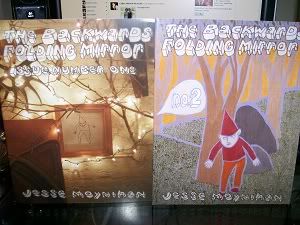
First off are the first two issues of L.A cartoonist Jesse Moynihan's The Backwards Folding Mirror.
I wasn't sure if I wanted to review these together or separately, but after realizing how much I have to write already, and how close in quality these were, I just tossed them together. The Backwards Folding Mirror is a story based on the author's troubled relationship with a past girlfriends (hence why there are only two issues, unfortunately for everyone but him), but with ghosts and talking animals thrown in.
It sounds awfully unappealing, I know. But between the excellent drawing and the great punchlines, I had a blast reading (and re-reading) these. A highlight is a joke about the ghost of his girlfriend's father watching over them while they sleep, but that was just one of the many times I laughed out loud at these great comics. Moynihan is currently working on a weekly online strip called Forming, about an alternate reality creation story, check it out here.
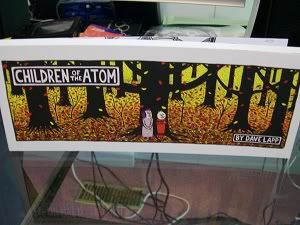
Carrying on with comics, but bringing it a little closer to home is Toronto artist Dave Lapp's book of collected Children of the Atom strips. I'm unsure of where these originally ran, but I sure am glad they were all collected into a single book. Many reviews I've read compare this strip to Samuel Beckett's plays, and while I don't think that it's totally off the wall, I think they are THE CLOSEST THING to Samuel Beckett that has happened in comics.
Featuring only two characters, each strip places Franklin Boy and Jim-Jam Girl in an often surreal situation while they constantly bicker back and forth, and while it's obvious they have some sort of connection, it's hard to put a finger on. That being said, each strip stands alone as being a self-contained story in five (give or take) panels. While that isn't uncommon, it's amazing how much content Lapp packs into each of them while at the same time being extremely modest with dialogue and generally simply movements.
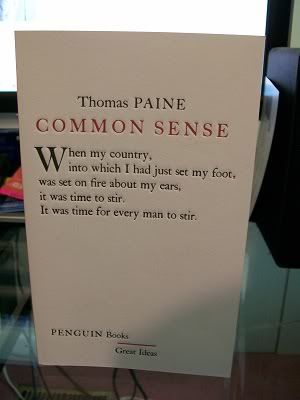
Stepping out of comics-dom for a moment, here's the 10th installment of Penguin's Great Ideas series with Thomas Paine's Common Sense. Cited as being one of the revolutionary sparks that landed on the haystack of colonial America, this was one of the most interesting (and quickly read) volumes of the series that I have read thus far.
Using common sense to persuade the colony of America into a fight for independence from their colonial masters, Paine looks at the redundancy of obeying a king literally half a world away as he points out that England will never come to assist America, while at the same time exploiting America for everything that it's worth. Sound familiar? I thought so. Reading this, one can't curb the urge to look at this in a modern context. Now that America has broken free of its English chains, it has shown no hesitation in condemning other nations to a fate that was once it's own. Sure, "colonialism" is treated as somewhat of a dirty word as of late and as such it's hard to claim that third world countries are really just colonies of the United States of America, but it's only a matter of time until thoughts similar to Paine's show up in places like Mexico.
This should be required reading for everyone, simply because it provides a much needed nudge to think critically of even the most obvious things in government. If it's too good to be true...

Following Paine's calls to question government, comes Mary Wollstonecraft's calls to question the prejudices that have plagued women from the dawn of society, in the form of A Vindication of the Rights of Woman, the 11th Great Ideas book.
I was glad upon reading this book that I was as enthralled with it as I was with Paine's work, after a couple minor let downs in the previous couple of books in this series. One of the first pieces of proto-feminist literature, A Vindication... laid down the claim that in order for women to mature to the fullest potential of human nature, they should be entitled to the same education as any man, and have the opportunity to pursue enjoyment in activities that were more intellectually stimulating than lives consisting of innocence, sensual exploits and an odd novel here and there.
What I found most interesting in reading this was that there was no open effort to attempt to make men and women equal (as seen by Wollstonecraft's frequent references to men as "the stronger sex"), but rather establishing herself as someone who I would argue set goals realistic at the time (in urging women to educate themselves)and laying down a female-positive intellectual framework. I really could go on about this for much longer, and maybe I will in another post, but I'll end this and say that the urging for intellectual growth is applicable to anyone, of any time period, regardless of gender. And simply viewing this as a piece of "feminist writing" is doing it a disservice.
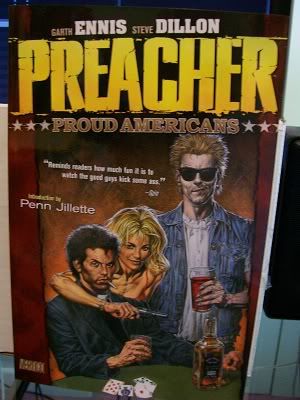
Time for a total reversal of subject and talk about the third volume of Garth Ennis and Steve Dillon's Preacher. Hailed as one of the most groundbreaking series in mainstream comics, I put off reading this for far too long and I've slowly been chugging through.
There's something about the series that just doesn't click for me, and I can't quite put my finger on it. I love Ennis' Punisher MAX, and I even enjoyed the first two volumes of Preacher but this one almost seemed like a struggle to read at times. I think it might be due to the amount of character back story that is revealed in this volume, I felt like I already had my own ideas of history in place for Cassidy and Jesse's dad and that revealing them in a way that conflicted with my own made it less enjoyable.
Qualms out of the way, I plan on continuing through the series, primarily due to the fact that the main story line is beginning to heat up in a big way and I love the subject matter, art and amount of violence in this series. (The end of this volume has a VERY satisfying splat, you'll understand once you read it.)
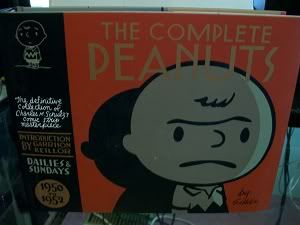
Accidentally blending the world of comic strips and philosophy, I set out on my summer goal to read through as many books of The Complete Peanuts as I could. Drawn by Charles Schulz (If this is news to you, climb out from your rock.), the first book compiles every strip and Sunday special from 1950-1952.
After casually reading Peanuts strips for as long as I can think back, there is a much different feeling reading them in a chronological format (and so many at once.). The book starts out with a small cast consisting only of Charlie Brown, Snoopy, Patty and Shermy, and slowly begins to grow, eventually involving Violet, Lucy, Schroeder and even a baby Linus towards the end. Watching the characters mature (I.E. Watching as Schulz became comfortable writing them) is probably the greatest part of the book. Containing over 700 strips, there is no shortage of laughs, and while it may not be Peanuts at it's prime, it's very clear that it is on its way to greatness.
Also included is an essay on Schulz' life by David Michaelis and even more excitingly, a reprinted interview with Schulz done by comic historian Rick Marshall and Fantagraphics Books co-founder Gary Groth. In it Schulz tells of his favorite comics and artists, least favorite comics and artists and also about his life in general, a great read. I look forward to reading more of these great collections by the time school resumes.
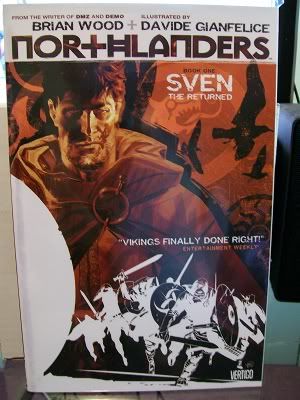
Following up a comic with an artist of Scandinavian descent with a comic about Scandinavians he may have (but hopefully did not) descended from, here's the first volume of Brian Wood and Davide Gianfelice's Northlanders.
I was itching to check this book out ever since I heard about it through the vast expanses of the internet, and after finally tracking down the first three volumes at a local comic store I jumped at the opportunity.
Totally worth it, beautiful art, great viking-style dialogue (the most eloquent of barbarians), and no shortage of battle axes to heads, arrows to the throat and decapitations. The story is so-so this far, but I'm not expecting anything to special from a series advertised as a crime series based around vikings. They aren't overly clever (save one), so why should the book be? I'll be reading the next two volume ASAP, and considering I made it through this 200 page book in a little under an hour, I feel like that will be an easy yet extremely rewarding task.
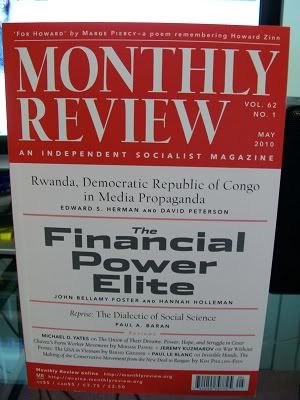
Totally unrelated, this is the May 2010 issue (Volume 62 NO.1) of Monthly Review, an "Independent Socialist Magazine".
I had my gripes last go-around with Relay as being sometimes too academic for its own good. It was good, but it focused far too much on dense economic theory, which is interesting in it's own right but there is no way to make it completely satisfying reading on it's own.
Monthly Review is great to balance that out. With some articles still bringing up the slightly intimidating numbers game (Such as John Foster and Hannah Holleman's The Financial Power Elite, it's done in a way that is much more accessible and most importantly it is less focused with trying to sound scholarly, and more focused on trying to convey a clear, concise message.
There's that, and there are also some articles that are just damn interesting, including stories of American involvement in the Rwandan genocide and subsequent resolutions, the history of the modern conservative movement, and the lack of politically left views when it comes to business and economic education.
This was my first time picking up this magazine, and I can easily see it being a monthly read.
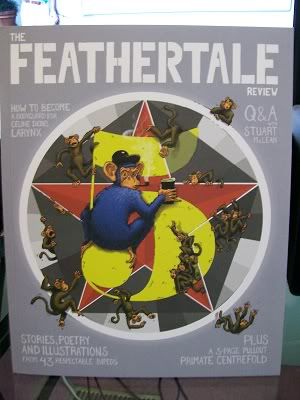
Then there was the fifth issue of The Feathertale Review...
I know I don't really have too many big problems with books I review here, especially not magazines, that being said, I'll assume I picked this one up on a weak issue.
Maybe I had high expectations, but I thought a humour magazine with a cover that advertises stories about protecting Celine Dion's voice box, a Q&A with Stuart Mclean and a "3-Page Pullout Primate Centrefold" to be funny. I expected it to be thoroughly funny. I got my laughs, don't get me wrong (mainly at the stories that were mentioned on the cover, now that I think about it) but as a whole it seemed like they were trying real, real hard to meet their promises of being funny.
Humour is a personal thing, and I'll assume that this may not have been my kind of humour. I'll try again next time, and hope that I'm more impressed.
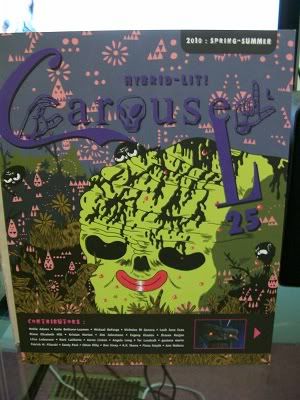
As a nice way to end off, here's a great art-focused magazine published through the University of Guelph, Carousel issue 25 (Spring/Summer 2010).
During my perfunctory flip through of the magazine after noticing the cover by Toronto cartoonist/artist Michael DeForge I noticed a great deal of things that I instantly enjoyed. Paintings/Illustrations, lots of them. Comics, a good deal of them. SHORT works/poems/interviews. Plus a great bare-bones layout that makes it real easy to read. Oh, and more Michael DeForge.
I can't say enough about this magazine, and for something that is put out through a University (not to mention one so close to me), this is amazing. And as a final point, I want to mention that this is the ideal length of a magazine in my opinion. Just under 70 pages, many of which are primarily images with little to no text to drown them out. Mark Laliberte's art made it a bit of a struggle to read the written pieces on the opposite page, but that was a small, small price to pay for this. I'm extremely impressed.

First off are the first two issues of L.A cartoonist Jesse Moynihan's The Backwards Folding Mirror.
I wasn't sure if I wanted to review these together or separately, but after realizing how much I have to write already, and how close in quality these were, I just tossed them together. The Backwards Folding Mirror is a story based on the author's troubled relationship with a past girlfriends (hence why there are only two issues, unfortunately for everyone but him), but with ghosts and talking animals thrown in.
It sounds awfully unappealing, I know. But between the excellent drawing and the great punchlines, I had a blast reading (and re-reading) these. A highlight is a joke about the ghost of his girlfriend's father watching over them while they sleep, but that was just one of the many times I laughed out loud at these great comics. Moynihan is currently working on a weekly online strip called Forming, about an alternate reality creation story, check it out here.

Carrying on with comics, but bringing it a little closer to home is Toronto artist Dave Lapp's book of collected Children of the Atom strips. I'm unsure of where these originally ran, but I sure am glad they were all collected into a single book. Many reviews I've read compare this strip to Samuel Beckett's plays, and while I don't think that it's totally off the wall, I think they are THE CLOSEST THING to Samuel Beckett that has happened in comics.
Featuring only two characters, each strip places Franklin Boy and Jim-Jam Girl in an often surreal situation while they constantly bicker back and forth, and while it's obvious they have some sort of connection, it's hard to put a finger on. That being said, each strip stands alone as being a self-contained story in five (give or take) panels. While that isn't uncommon, it's amazing how much content Lapp packs into each of them while at the same time being extremely modest with dialogue and generally simply movements.

Stepping out of comics-dom for a moment, here's the 10th installment of Penguin's Great Ideas series with Thomas Paine's Common Sense. Cited as being one of the revolutionary sparks that landed on the haystack of colonial America, this was one of the most interesting (and quickly read) volumes of the series that I have read thus far.
Using common sense to persuade the colony of America into a fight for independence from their colonial masters, Paine looks at the redundancy of obeying a king literally half a world away as he points out that England will never come to assist America, while at the same time exploiting America for everything that it's worth. Sound familiar? I thought so. Reading this, one can't curb the urge to look at this in a modern context. Now that America has broken free of its English chains, it has shown no hesitation in condemning other nations to a fate that was once it's own. Sure, "colonialism" is treated as somewhat of a dirty word as of late and as such it's hard to claim that third world countries are really just colonies of the United States of America, but it's only a matter of time until thoughts similar to Paine's show up in places like Mexico.
This should be required reading for everyone, simply because it provides a much needed nudge to think critically of even the most obvious things in government. If it's too good to be true...

Following Paine's calls to question government, comes Mary Wollstonecraft's calls to question the prejudices that have plagued women from the dawn of society, in the form of A Vindication of the Rights of Woman, the 11th Great Ideas book.
I was glad upon reading this book that I was as enthralled with it as I was with Paine's work, after a couple minor let downs in the previous couple of books in this series. One of the first pieces of proto-feminist literature, A Vindication... laid down the claim that in order for women to mature to the fullest potential of human nature, they should be entitled to the same education as any man, and have the opportunity to pursue enjoyment in activities that were more intellectually stimulating than lives consisting of innocence, sensual exploits and an odd novel here and there.
What I found most interesting in reading this was that there was no open effort to attempt to make men and women equal (as seen by Wollstonecraft's frequent references to men as "the stronger sex"), but rather establishing herself as someone who I would argue set goals realistic at the time (in urging women to educate themselves)and laying down a female-positive intellectual framework. I really could go on about this for much longer, and maybe I will in another post, but I'll end this and say that the urging for intellectual growth is applicable to anyone, of any time period, regardless of gender. And simply viewing this as a piece of "feminist writing" is doing it a disservice.

Time for a total reversal of subject and talk about the third volume of Garth Ennis and Steve Dillon's Preacher. Hailed as one of the most groundbreaking series in mainstream comics, I put off reading this for far too long and I've slowly been chugging through.
There's something about the series that just doesn't click for me, and I can't quite put my finger on it. I love Ennis' Punisher MAX, and I even enjoyed the first two volumes of Preacher but this one almost seemed like a struggle to read at times. I think it might be due to the amount of character back story that is revealed in this volume, I felt like I already had my own ideas of history in place for Cassidy and Jesse's dad and that revealing them in a way that conflicted with my own made it less enjoyable.
Qualms out of the way, I plan on continuing through the series, primarily due to the fact that the main story line is beginning to heat up in a big way and I love the subject matter, art and amount of violence in this series. (The end of this volume has a VERY satisfying splat, you'll understand once you read it.)

Accidentally blending the world of comic strips and philosophy, I set out on my summer goal to read through as many books of The Complete Peanuts as I could. Drawn by Charles Schulz (If this is news to you, climb out from your rock.), the first book compiles every strip and Sunday special from 1950-1952.
After casually reading Peanuts strips for as long as I can think back, there is a much different feeling reading them in a chronological format (and so many at once.). The book starts out with a small cast consisting only of Charlie Brown, Snoopy, Patty and Shermy, and slowly begins to grow, eventually involving Violet, Lucy, Schroeder and even a baby Linus towards the end. Watching the characters mature (I.E. Watching as Schulz became comfortable writing them) is probably the greatest part of the book. Containing over 700 strips, there is no shortage of laughs, and while it may not be Peanuts at it's prime, it's very clear that it is on its way to greatness.
Also included is an essay on Schulz' life by David Michaelis and even more excitingly, a reprinted interview with Schulz done by comic historian Rick Marshall and Fantagraphics Books co-founder Gary Groth. In it Schulz tells of his favorite comics and artists, least favorite comics and artists and also about his life in general, a great read. I look forward to reading more of these great collections by the time school resumes.

Following up a comic with an artist of Scandinavian descent with a comic about Scandinavians he may have (but hopefully did not) descended from, here's the first volume of Brian Wood and Davide Gianfelice's Northlanders.
I was itching to check this book out ever since I heard about it through the vast expanses of the internet, and after finally tracking down the first three volumes at a local comic store I jumped at the opportunity.
Totally worth it, beautiful art, great viking-style dialogue (the most eloquent of barbarians), and no shortage of battle axes to heads, arrows to the throat and decapitations. The story is so-so this far, but I'm not expecting anything to special from a series advertised as a crime series based around vikings. They aren't overly clever (save one), so why should the book be? I'll be reading the next two volume ASAP, and considering I made it through this 200 page book in a little under an hour, I feel like that will be an easy yet extremely rewarding task.

Totally unrelated, this is the May 2010 issue (Volume 62 NO.1) of Monthly Review, an "Independent Socialist Magazine".
I had my gripes last go-around with Relay as being sometimes too academic for its own good. It was good, but it focused far too much on dense economic theory, which is interesting in it's own right but there is no way to make it completely satisfying reading on it's own.
Monthly Review is great to balance that out. With some articles still bringing up the slightly intimidating numbers game (Such as John Foster and Hannah Holleman's The Financial Power Elite, it's done in a way that is much more accessible and most importantly it is less focused with trying to sound scholarly, and more focused on trying to convey a clear, concise message.
There's that, and there are also some articles that are just damn interesting, including stories of American involvement in the Rwandan genocide and subsequent resolutions, the history of the modern conservative movement, and the lack of politically left views when it comes to business and economic education.
This was my first time picking up this magazine, and I can easily see it being a monthly read.

Then there was the fifth issue of The Feathertale Review...
I know I don't really have too many big problems with books I review here, especially not magazines, that being said, I'll assume I picked this one up on a weak issue.
Maybe I had high expectations, but I thought a humour magazine with a cover that advertises stories about protecting Celine Dion's voice box, a Q&A with Stuart Mclean and a "3-Page Pullout Primate Centrefold" to be funny. I expected it to be thoroughly funny. I got my laughs, don't get me wrong (mainly at the stories that were mentioned on the cover, now that I think about it) but as a whole it seemed like they were trying real, real hard to meet their promises of being funny.
Humour is a personal thing, and I'll assume that this may not have been my kind of humour. I'll try again next time, and hope that I'm more impressed.

As a nice way to end off, here's a great art-focused magazine published through the University of Guelph, Carousel issue 25 (Spring/Summer 2010).
During my perfunctory flip through of the magazine after noticing the cover by Toronto cartoonist/artist Michael DeForge I noticed a great deal of things that I instantly enjoyed. Paintings/Illustrations, lots of them. Comics, a good deal of them. SHORT works/poems/interviews. Plus a great bare-bones layout that makes it real easy to read. Oh, and more Michael DeForge.
I can't say enough about this magazine, and for something that is put out through a University (not to mention one so close to me), this is amazing. And as a final point, I want to mention that this is the ideal length of a magazine in my opinion. Just under 70 pages, many of which are primarily images with little to no text to drown them out. Mark Laliberte's art made it a bit of a struggle to read the written pieces on the opposite page, but that was a small, small price to pay for this. I'm extremely impressed.
Subscribe to:
Posts (Atom)






